Physical Address
304 North Cardinal St.
Dorchester Center, MA 02124
Acute kidney injury (AKI) consists of any precipitous decline in renal filtration function, which can occur secondary to disease affecting the renal vasculature, renal parenchyma, or urine collecting system. Such a decline is often first evidenced as an increase in serum creatinine concentration, which may be accompanied by normal urine output, oliguria, or anuria.
Over time, various criteria have been proposed to define what degree of functional impairment constitutes AKI. The Acute Dialysis Quality Initiative (ADQI) created a consensus definition known as the RIFLE criteria, which stratifies patients based on serum creatinine concentration, estimated glomerular filtration rate (GFR), and urine output. A modification of these criteria was subsequently proposed by the Acute Kidney Injury Network (AKIN) since smaller changes in serum creatinine than proposed by the RIFLE criteria can have adverse effects on outcome. The criteria include:
Stage 1 AKI: increase in serum creatinine by ≥0.3 mg/dL or by 150% to 200%, OR urine output <0.5 mL/kg/hr for 6 hours
Stage 2 AKI: increase in serum creatinine by 200% to 300%, OR urine output <0.5 mL/kg/hr for 12 hours
Stage 3 AKI: increase in serum creatinine by >300% or to more than 4.0 mg/dL with an acute increase of greater than 0.5 mL/dL, OR urine output <0.3 mL/kg/hr for 24 hours, anuria for 12 hours or renal replacement therapy
These diagnoses should be applied only if the decline in renal function occurs over a rapid time course (i.e., less than 48 hours). There are several issues that may complicate application of these criteria. First, they require knowledge of the patient's baseline renal function. Second, serum creatinine concentrations may not be in a steady state in patients with declining renal function. Research efforts into more sensitive bio markers of renal injury, such as cystatin C and neutrophil gelatinase-associated lipocalin (NGAL), are ongoing but have not yet had a wide impact on clinical practice.
The various etiologies responsible for AKI are typically categorized as “prerenal,” “intrarenal,” or “postrenal.”
“Prerenal” AKI, the most common kind (60% of cases), reflects a significant reduction in renal perfusion. Mild reductions in renal perfusion do not affect the glomerular filtration rate (GFR) because of compensatory feedback responses, such as activation of the renin-angiotensin system and release of vasodilatory prostaglandins (see Plate 3-18 ). In the setting of markedly reduced flow, however, these compensatory mechanisms fail, and renal filtration declines. By definition, however, the renal parenchyma remains intact, and normal function can be restored with intravascular fluid repletion.
Common causes of prerenal AKI include excessive diuresis, diarrhea, vomiting, hemorrhage, burns, poor cardiac output (i.e., congestive heart failure, see Plate 4-38 ), liver failure (i.e., hepatorenal syndrome, see Plate 4-40 ), and hypercalcemia (due to renal vasoconstriction). In addition, patients with low baseline renal perfusion may experience prerenal AKI if their normal compensatory mechanisms are blocked by either nonsteroidal antiinflammatory drugs (e.g., ibuprofen), which interfere with tubuloglomerular feedback, or inhibitors of the renin-angiotensin system (i.e., angiotensin-converting enzyme [ACE] inhibitors, aldosterone receptor blockers [ARBs]).
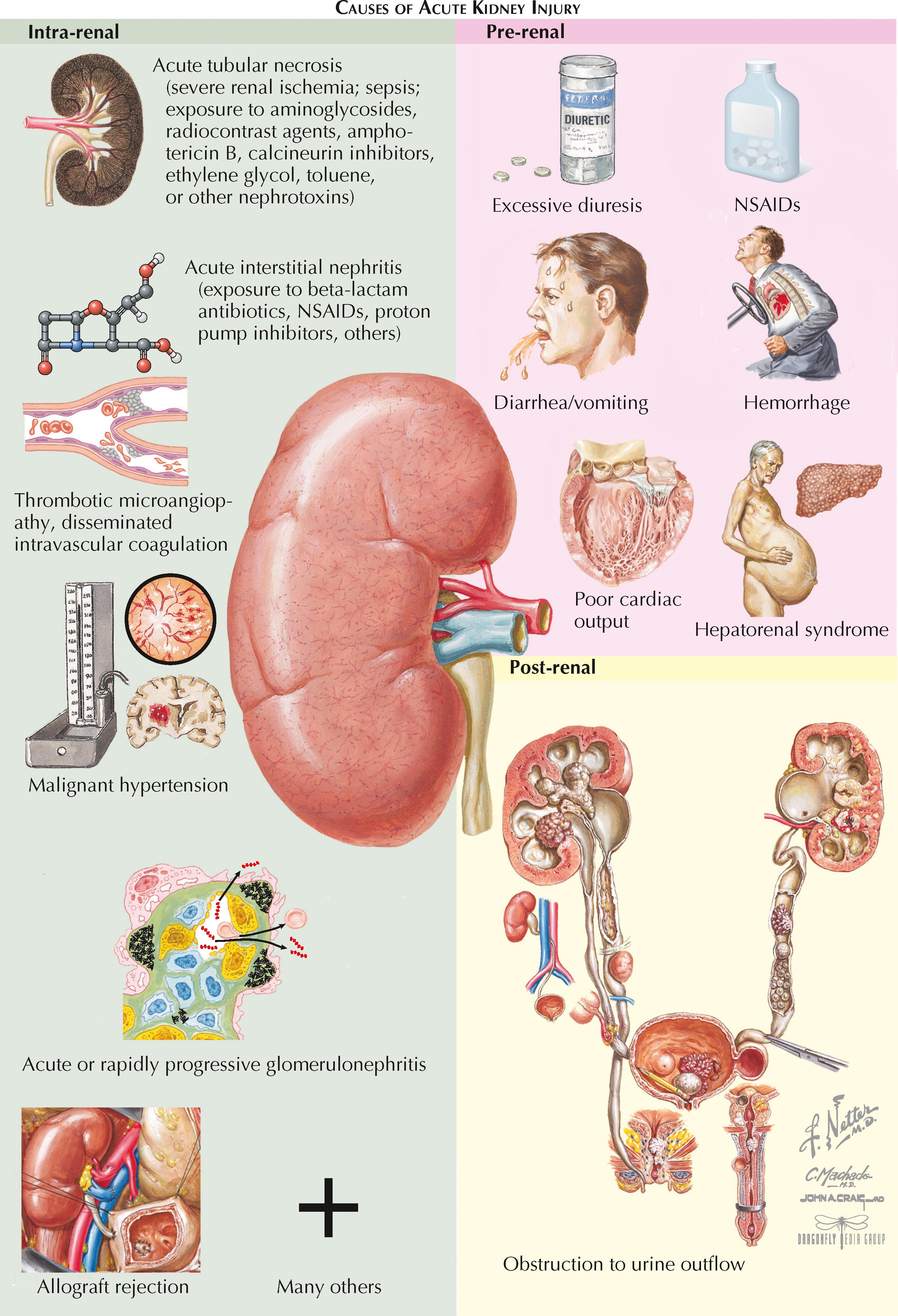
Patients with prerenal AKI may exhibit other signs of volume depletion, such as tachycardia, orthostatic hypotension, and dry mucous membranes. In addition, prerenal AKI can be distinguished from other causes by the intense reabsorption of solutes that results from the normal renal response to decreased perfusion. Specifically the fractional excretion of sodium (FENa, see Plate 3-6 for formula) should be low (<1%); the serum blood urea nitrogen (BUN):creatinine ratio may be elevated (i.e., >20 : 1), reflecting increased reabsorption of urea; and the urine should be concentrated (> 500 mOsm/kg H 2 O). Note that FENa values may be invalid among patients who have recently taken diuretics; in this case, the fractional excretion of urea has been proposed as an alternative means of assessing tubular reabsorption because it is generally less than 35% in the prerenal state. Finally, because the renal parenchyma is not damaged, the urine sediment should not contain red blood cells, white blood cells, or other markers of renal inflammation. Hyaline casts, however, may be seen; these occur because low tubular flow rates increase aggregation of Tamm-Horsfall mucoproteins, which are secreted by the distal tubular epithelium.
Once prerenal AKI is suspected, the diagnosis can be confirmed by documenting normalization of renal function upon resuscitation of intravascular volume.
“Intrarenal” AKI, the second most common kind (35% of cases), reflects direct damage to the renal parenchyma. Acute tubular necrosis (ATN, see Plate 4-3 ) accounts for nearly 90% of cases and is by far the most common cause. ATN occurs in the setting of either severe renal ischemia or direct toxic damage to the renal tubules by either extrinsic toxins (such as aminoglycosides or radiocontrast agents) or intrinsic toxins (such as myoglobin or hemoglobin). The many other causes of intrarenal AKI include acute or rapidly progressive glomerulonephritis (GN, see Plate 4-14 ), thrombotic microangiopathy (see Plate 4-32 ), disseminated intravascular coagulation, malignant hypertension (see Plate 4-44 ), acute interstitial nephritis (AIN, see Plate 4-28 ), and post-transplant renal allograft rejection.
Unlike prerenal AKI, intrarenal AKI does not improve in response to an intravenous fluid bolus. In addition, it generally does not produce evidence of increased tubular reabsorption. Thus the FENa is often >2%, the BUN : creatinine ratio is 10 to 15 : 1, and the urine osmolality is ≤400 mOsm/kg.
Intrarenal AKI may also be distinguished by findings on urine microscopy that indicate glomerular or tubular damage. ATN, for example, is often (but not always) associated with “muddy brown” pigmented granular casts or tubular epithelial cell casts. GN is associated with evidence of glomerular bleeding (dysmorphic red blood cells [RBCs], red blood cell casts; see Plate 4-14 for details). AIN is associated with white blood cell casts, white blood cells, and RBCs. In addition, glomerular and interstitial diseases are often associated with proteinuria, unlike prerenal or postrenal disease.
Finally, several glomerulonephritides cause abnormal complement levels, which are generally not seen in prerenal or postrenal disease unless the patient has other comorbidities. Additional details are available later in this section.
Once intrarenal AKI is suspected, the diagnosis of ATN is often reached based on history and laboratory findings. If a cause other than ATN appears likely, however, and the patient's renal function is not improving, a renal biopsy is often performed.
“Postrenal” AKI, the least common kind (5% of cases), reflects obstruction to urine flow from both kidneys (or in a solitary kidney). The obstructions must therefore affect the urethra, bladder neck, or both ureters. Such obstructions are often associated with intense flank and groin pain, which results from stretching of the proximal collecting system. Although flank pain may also occur in intrinsic renal diseases, referred pain to the groin indicates lower tract inflammation and is more suggestive of obstruction. The patient may offer a history of weak urine stream or incomplete emptying. On examination, an enlarged bladder or prostate (in men) may be palpable. Microscopic analysis of urine may be unremarkable or may reveal RBCs in the case of nephrolithiasis.
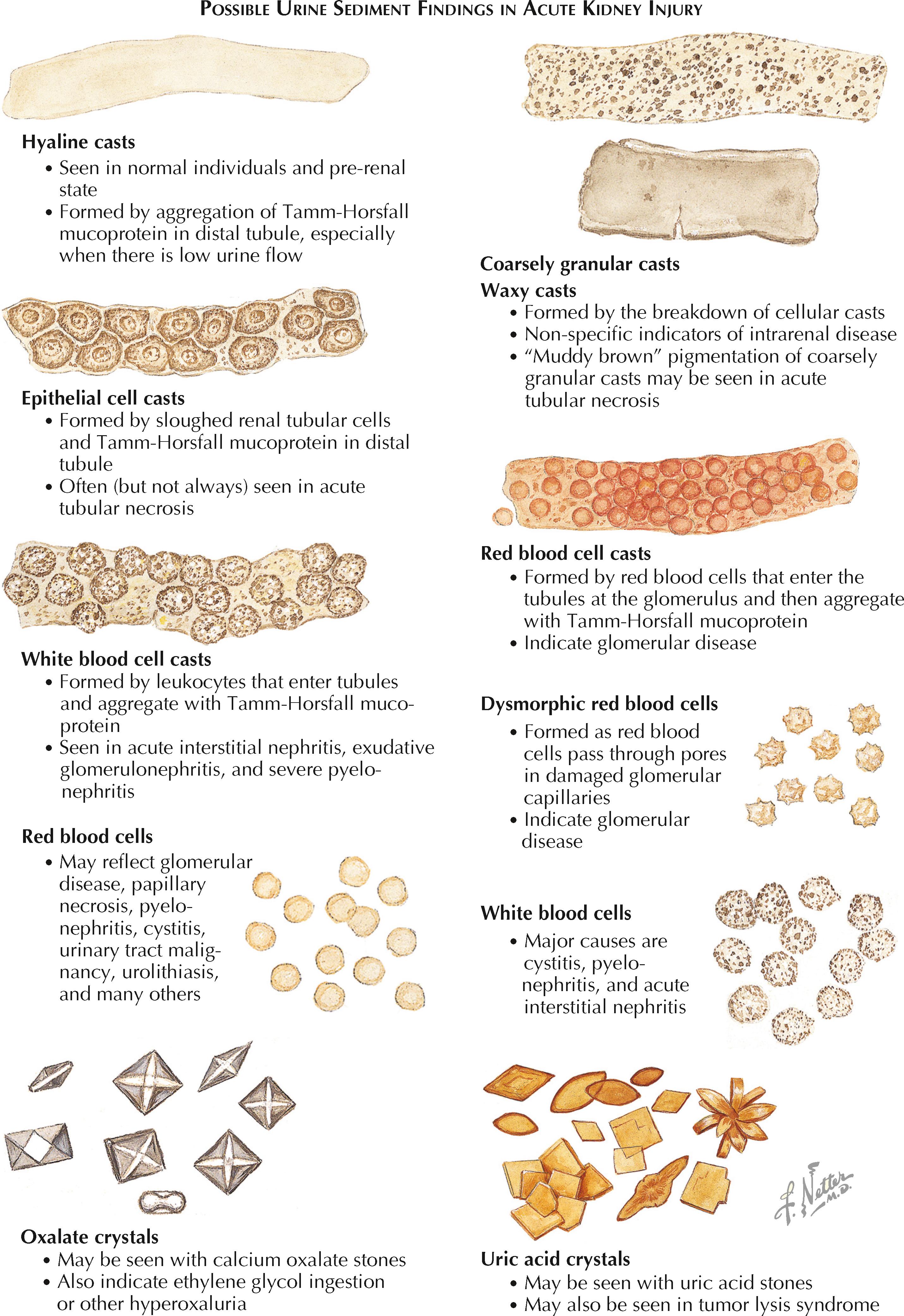
Once postrenal AKI is suspected, the patient should undergo further evaluation with radiographic imaging to further characterize the obstruction.
The specific management of these various etiologies is discussed later in this book. Irrespective of the cause, however, clinicians should be cognizant of the common sequelae of severely impaired renal function, such as fluid retention (with subsequent hypertension and edema), hyperkalemia, and metabolic acidosis. Any of these conditions, if not correctable with medications, may require renal replacement therapy.
Acute tubular necrosis (ATN) is one of the most common causes of acute kidney injury (AKI), accounting for over 90% of intrarenal AKI. It is characterized by a sudden decline in glomerular filtration rate (GFR) as a result of direct tubular damage.
ATN is typically classified as ischemic, septic, or toxic.
Ischemic ATN occurs when there is a decrease in renal perfusion that is severe and sustained enough to injure the tubular epithelium. Such damage typically occurs in the setting of circulatory collapse or massive hemorrhage.
Septic ATN involves direct cytokine-induced damage to the renal tubules. Ischemic damage may also occur if there is extensive systemic vasodilation.
Toxic ATN has been associated with numerous toxins that damage the tubular epithelium through a variety of mechanisms, which include production of free radicals, constriction of renal microvasculature, and tubular obstruction (i.e., via formation of crystals and/or casts). Major exogenous toxins include iodinated radiocontrast agents, antibiotics (e.g., aminoglycosides), antivirals (e.g., cidofovir), antifungals (e.g., amphotericin B), calcineurin inhibitors (e.g., cyclosporine and tacrolimus), ethylene glycol, and toluene. Major endogenous toxins include myoglobin, hemoglobin, oxalate, uric acid (i.e., in tumor lysis syndrome), and myeloma light chains. In fact, the first cases of ATN, described in World War II, were likely the result of excessive myoglobin released into the circulation during crush injuries.
Although these agents injure the tubular epithelium, the structural damage is often inadequate to explain the dramatic decline in the overall glomerular filtration rate. In addition, creatinine undergoes a far greater degree of filtration than secretion, but serum concentrations are nonetheless markedly elevated. Thus three mechanisms have been proposed to relate the physiologic findings to the histologic changes: (1) tubuloglomerular feedback, (2) tubular obstruction, and (3) back leak.
The “tubuloglomerular feedback” hypothesis argues that tubular damage results in decreased proximal reabsorption of electrolytes, including sodium and chloride, which leads to elevated concentrations of these solutes at the macula densa. Through the mechanisms described in Plate 3-18 , the macula densa triggers intense vasoconstriction of the afferent arteriole, which reduces the filtration rate.
The “tubular obstruction” hypothesis argues that sloughing of epithelial cells into the tubular lumen produces obstructive casts, which increase the hydrostatic pressure in Bowman's space and thereby decrease filtration.
The “back leak” hypothesis argues that the damaged tubular epithelium and endothelium permits paracellular reabsorption of filtered molecules, including creatinine, into the interstitium.
The prevailing opinion among nephrologists is that the tubuloglomerular feedback hypothesis accounts for a majority of the observed decline in filtration, although it is possible that all three mechanisms contribute to some degree.
The clinical course is generally divided into three phases: initiation, maintenance, and recovery. The initiation phase corresponds to the period during which the patient is exposed to the toxic insult and experiences an immediate decline in GFR and urine output. The maintenance phase occurs after the renal injury is established but before recovery occurs, and it is characterized by a stable but low GFR. This phase has been reported to last between several hours and several months, with a median length of 1 to 3 weeks. The recovery phase, if it occurs at all, corresponds to regeneration of renal tubules and normalization of renal function. This period is often associated with polyuria because of the impaired concentrating ability of immature tubular cells. Eventually, reabsorption capacity returns to normal, and polyuria ceases.
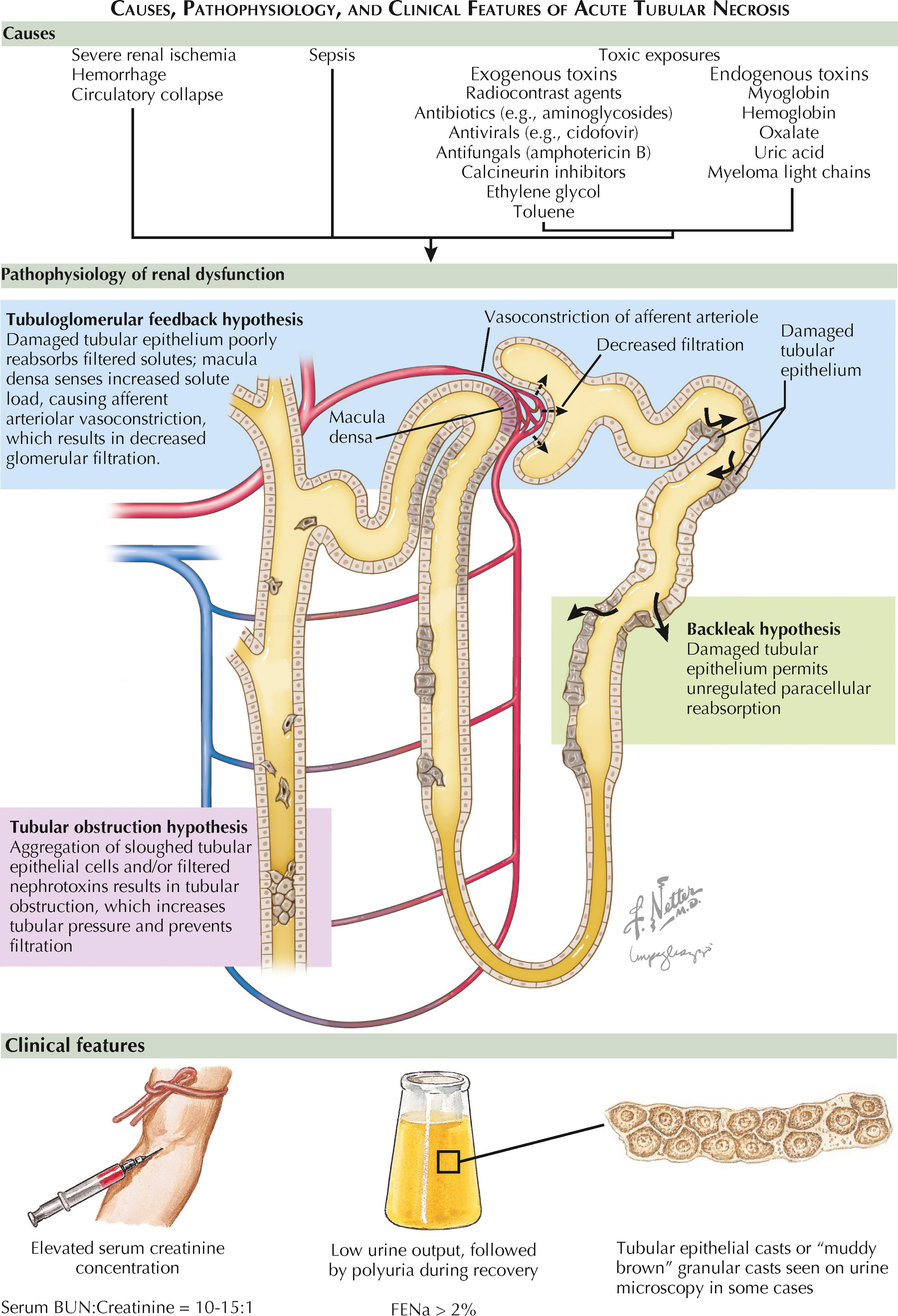
The first manifestation of disease is typically a sharp increase in serum creatinine concentration on routine laboratory examination. Recent exposure to a known nephrotoxin strongly suggests the diagnosis of ATN, whereas hemodynamic compromise may cause either prerenal state or ATN. Thus distinguishing between prerenal state and ATN is often an important part of the differential diagnosis. As described in the overview of AKI, the distinction between prerenal and intrarenal disease can often be established based on the response to an intravenous fluid bolus, as well as laboratory markers such as FENa and the BUN : creatinine ratio. Microscopic analysis of urine may also facilitate the diagnosis. In the prerenal state, urine either appears normal or contains hyaline casts, which form when Tamm-Horsfall protein, secreted in the distal tubule, becomes concentrated and aggregates. In contrast, ATN often features “muddy-brown” granular casts or epithelial casts.
These laboratory indicators, however, can sometimes be unreliable. Contrast-induced ATN, for example, initially causes a high BUN : creatinine ratio and low FENa, which could be misinterpreted as evidence of prerenal state. Instead, these values reflect the intense renal vasoconstriction associated with contrast agents. For as long as the tubular epithelium remains intact, such vasoconstriction causes increased sodium reabsorption. As the ischemia persists, however, tubular cells become injured and their ability to reabsorb sodium is lost, leading to laboratory values more consistent with ATN.
The diagnosis of ATN is typically established based on clinical and laboratory criteria. Renal biopsy is generally not performed unless intrarenal AKI secondary to another cause, such as rapidly progressive glomerulonephritis (see Plate 4-25 ), is suspected. Nonetheless, ATN is associated with a spectrum of common pathologic findings, irrespective of the cause, which can include shortening or loss of the proximal tubular brush border, epithelial cell flattening and simplification, nucleolar prominence, hypereosinophilia, and sloughing of tubular epithelial cells. Despite the name, actual frank necrosis is only an occasional finding. The degree of injury is often dependent on the severity of the exposure, rather than the identity of the specific agent. These pathologic changes can occur in both proximal and distal nephron segments.
The treatment of ATN consists of identifying and eliminating the underlying cause, as well as implementing supportive measures and initiating renal replacement therapy when appropriate. Supportive strategies include strict attention to fluids and electrolytes, as well as limiting the administration of substances that undergo primarily renal clearance. If these strategies are followed, dialysis can often be avoided in cases of prolonged ATN. For example, furosemide can be used to increase diuresis, which can treat volume overload and hyperkalemia. Likewise, bicarbonate can be used to correct acidemia. Occasionally, severe cases of ATN cannot be managed supportively, and dialysis must be initiated. The major indications include acidosis, fluid overload, and hyperkalemia that are refractory to medical management, as well as signs of uremia such as pericarditis or encephalopathy. There are no proven therapies that “reverse” ATN.
Because there are no effective therapies that reverse the clinical or pathologic changes associated with ATN, mortality remains high and, despite decades of intense research, has not changed over the past 50 years. Mortality rates have been reported to be up to 40% in hospitalized patients with ATN and up to 80% in critically ill patients with ATN.
Many patients who survive ATN experience an eventual normalization of renal function. Some, however, sustain moderate to severe tubulointerstitial scarring that leads to chronic kidney disease (CKD), with about 5% to 10% ultimately requiring long-term dialysis. Risk factors for nonresolving renal function after ATN include persistent septic physiology, recurrent nephrotoxin administration, and preexisting chronic kidney disease.
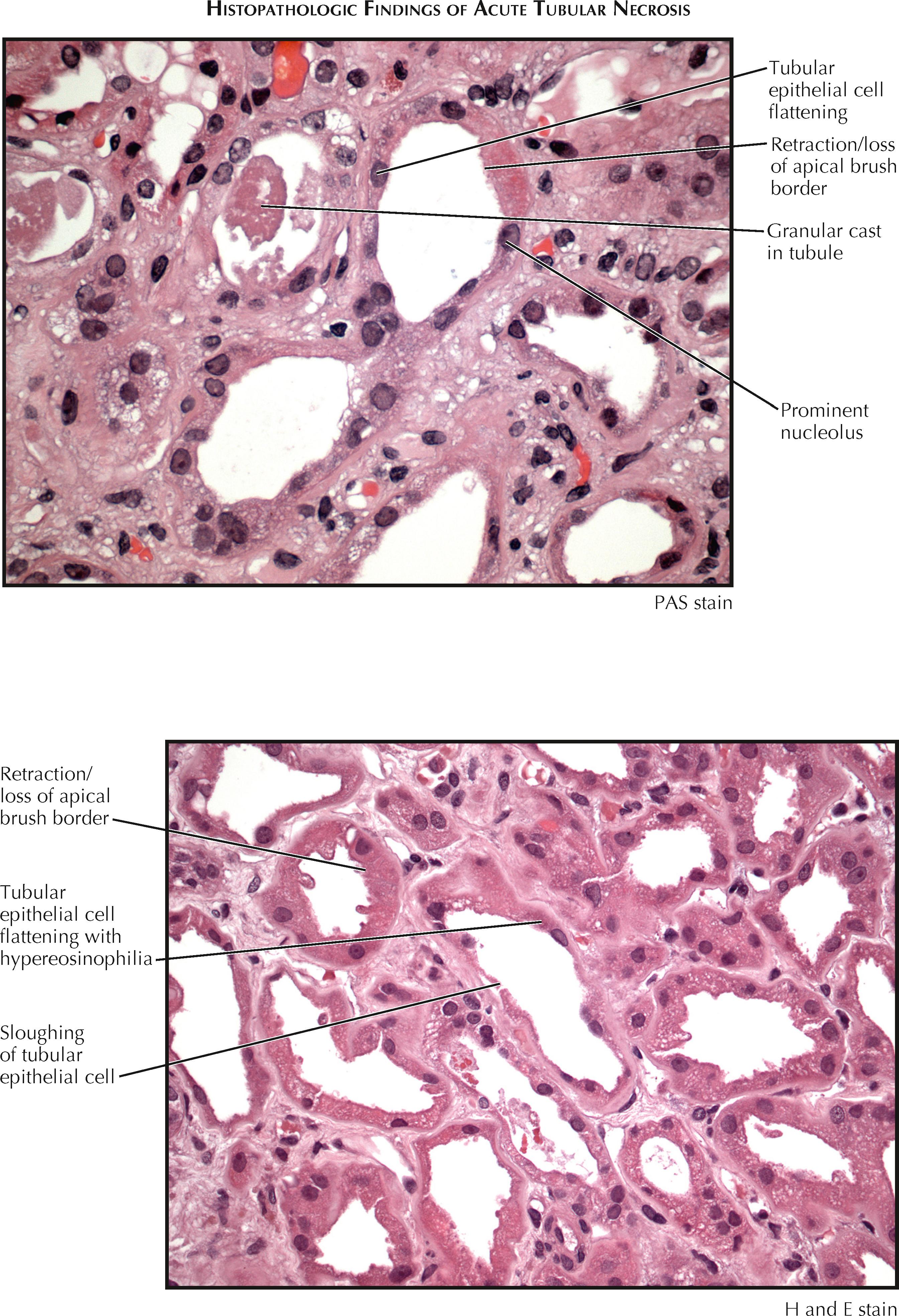
The most effective prevention strategy is to maintain euvolemia in hospitalized patients and to avoid excessive exposure to nephrotoxic agents, especially in patients with preexisting renal disease.
In situations where ATN could be expected, such as during administration of intravenous radiocontrast, maintaining euvolemia and limiting the dye load might be expected to reduce the risk of this complication. Other measures—including the use of antioxidants, natriuretic peptides, and high dose furosemide/mannitol—have not been shown to consistently decrease the risk of ATN.
Multiple risk scores have been devised to predict which patients are at highest risk for developing ATN and which will have the poorest outcome. The risk factors overlap, and they include variables that predict preexisting histologic damage and at predispose to renal ischemia, including male sex, advanced age, comorbid illness, malignancy, volume depletion/oliguria, sepsis, and multiorgan failure.
The nephrotic syndrome encompasses a constellation of clinical and laboratory findings related to the loss of large quantities of protein in urine. The major symptom is edema, and the laboratory findings include (1) “nephrotic-range” proteinuria, defined in adults as more than 3.5 g of protein excretion per 24 hours, (2) hypoalbuminemia, and (3) hyperlipidemia. The threshold for nephrotic proteinuria in children is lower and depends on body weight.
“Nephrotic syndrome” is a nonspecific diagnosis that suggests underlying glomerular disease. The normal, noninflamed glomerulus forms a tight barrier to proteins, such as albumin, largely because of the slit diaphragms that connect podocyte (visceral epithelial cell) foot processes on the outside surface of the glomerular basement membrane.
In nephrotic syndrome, inflammation disrupts the normal structure of the slit diaphragms, permitting the passage of potentially large amounts of protein into the urine. In most cases, the foot processes appear “fused” or “effaced,” meaning that a continuous layer of podocyte cytoplasm is seen over the glomerular capillaries, rather than the discrete, individual processes seen in the normal state. Such effacement reflects widening, shortening, and retraction of the foot processes. Although the glomerular inflammation is typically not severe enough to cause an acute decline in overall filtration, scarring and loss of renal function may occur over time.
The ongoing loss of albumin into urine causes hypoalbuminemia. The decline in serum albumin concentration, however, is often out of proportion to the degree of proteinuria. One possible explanation is that the proximal tubular catabolism of albumin is accelerated because of the increased filtered load.
In response to the low serum albumin concen-trations, the liver increases its production of numer-ous proteins, including lipoproteins, leading to hyperlipidemia.
Edema occurs for at least two possible reasons. The first, known as the “underfilling hypothesis,” argues that low serum albumin concentrations lead to a reduction in intravascular oncotic pressure. As a result, plasma moves from the capillary lumen to the interstitium, which leads to edema. The resulting intravascular depletion activates the renin-angiotensin-aldosterone system, which promotes retention of sodium and water and thus further worsens the edema. The second hypothesis, known as the “overfilling hypothesis,” argues that there is primary retention of sodium at the level of the collecting duct, perhaps triggered by the filtered proteins themselves, that leads to edema. It appears probable that both hypotheses are correct, and that the primary mechanism for edema may vary across patients and across time.
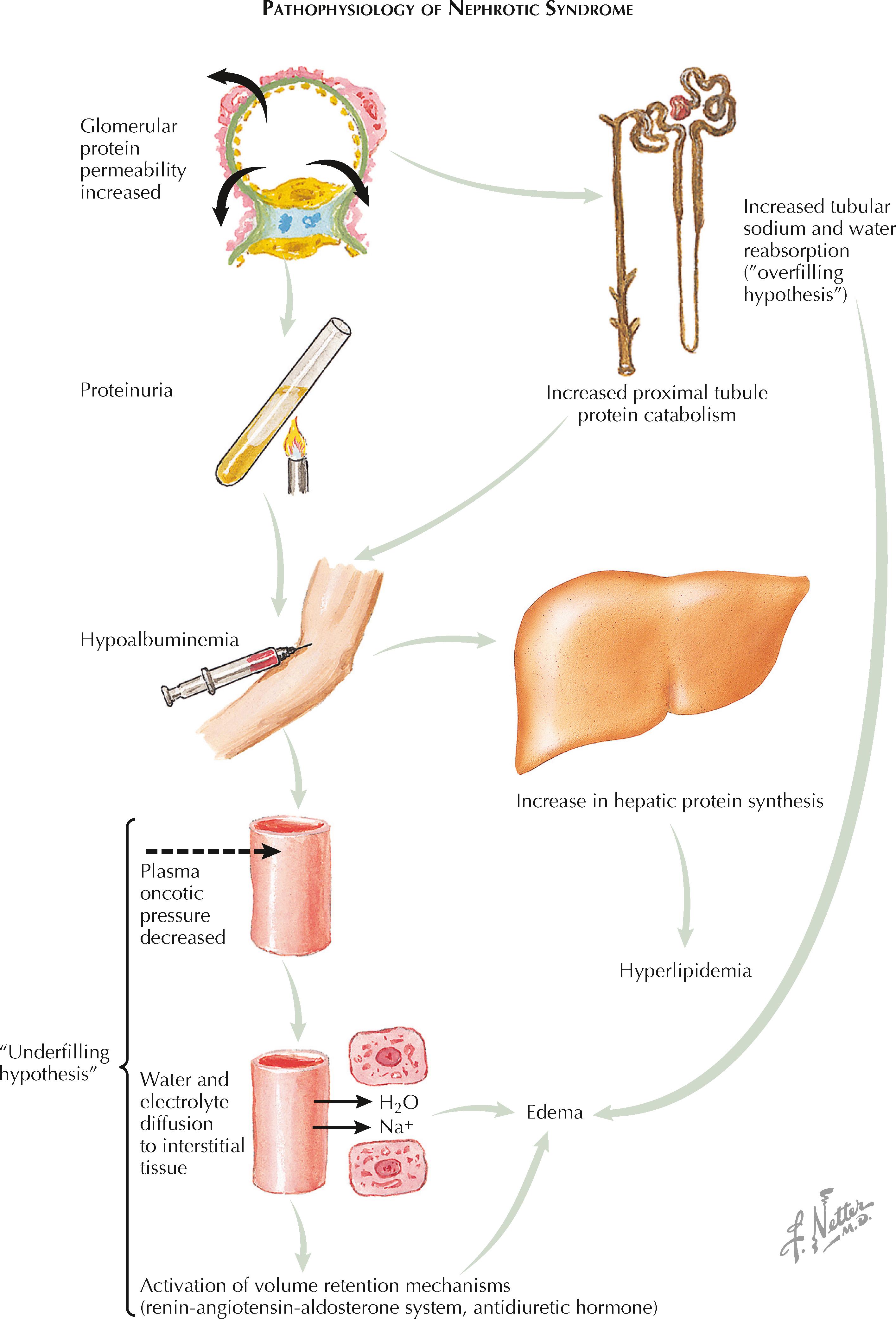
Patients with nephrotic syndrome are at increased risk for lower extremity, pulmonary, and renal vein thromboses (see Plate 4-35 ) because of urinary losses of anticoagulant proteins, such as antithrombin and plasminogen, as well as increased hepatic production of procoagulant proteins, such as fibrinogen and other clotting factors. Among the nephrotic syndromes, thromboses are most often seen in patients with membranous nephropathy, but any patient with proteinuria above 10 g/day and albumin levels below 2 g/dL should be considered at risk.
Three primary glomerular diseases—minimal change disease (MCD, see Plate 4-8 ), focal segmental glomerulosclerosis (FSGS, see Plate 4-10 ), and membranous nephropathy (MN, see Plate 4-12 )—all cause significant proteinuria, which is often sufficient to result in nephrotic syndrome.
Other primary glomerular diseases, such as the various glomerulonephritides (see Plate 4-14 ), typically cause proteinuria, hematuria, and a variable degree of renal dysfunction. In a subset of cases, the proteinuria is sufficient to result in nephrotic syndrome.
Finally, many systemic conditions or environmental agents can cause nephrotic syndrome, either by causing a distinct pattern of glomerular inflammation (i.e., amyloidosis see Plate 4-47 ], diabetes mellitus [see Plate 4-45 ]) or by causing one of the renal diseases listed previously. Examples of the latter include secondary MCD in the setting of lymphoma, infection (e.g., tuberculosis), allergies, and lithium or NSAID use; secondary FSGS in the setting of HIV infection, heroin abuse, and sickle cell disease; and secondary MN in the setting of systemic lupus erythematosus, rheumatoid arthritis, viral hepatitis infection, syphilis, penicillamine use, gold poisoning, and solid tumors in general.
In both children and adults, the annual incidence of nephrotic syndrome is approximately five cases per 100,000 individuals. This incidence, however, likely underestimates the true disease burden because many cases, especially those secondary to diabetes, do not undergo biopsy-proven diagnosis.
There are strong age and race predilections for the various causes of nephrotic syndrome. In children, the most common cause by far is MCD. In adults, the most common cause of secondary nephrotic syndrome is diabetes mellitus, whereas the two most common causes of idiopathic nephrotic syndrome are MN and FSGS. Until recently, MN was the most common cause in white adults, whereas FSGS was the most common cause in black adults. More recent data, however, shows a steadily rising incidence of FSGS, in part because of the large number of cases occurring secondary to obesity. As a result, FSGS may soon emerge as the most common cause of idiopathic nephrotic syndrome in all adults.
Edema is the most common presenting symptom. Gravity increases intracapillary hydrostatic pressure and is thus the major determinant of the extravascular fluid distribution. Thus edema is typically most severe in the lower extremities; however, after sleeping in a prone position, the patient may experience swelling of the face, especially in the periorbital region. Severe fluid retention can also lead to pulmonary edema (with associated shortness of breath), effusions, or frank anasarca. Hypertension may occur in a minority of patients. Finally, patients may also describe weakness, malaise, and a “foamy” or “bubbly” appearance to their urine.
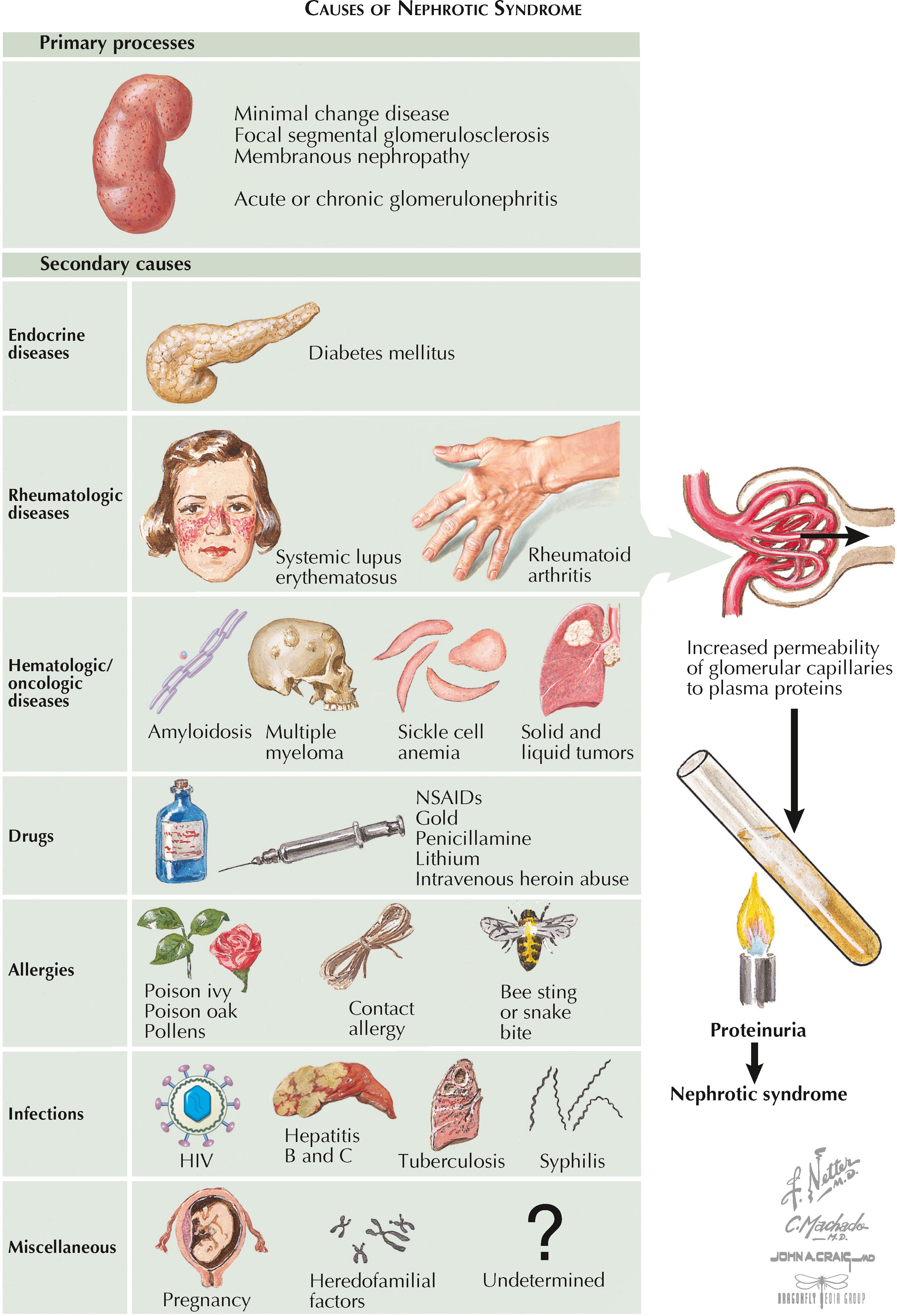
Patients with edema do not necessarily have nephrotic syndrome, since other diseases—notably congestive heart failure and cirrhosis—can present in this fashion. The diagnosis of nephrotic syndrome is suggested, however, when urine dipstick reveals marked proteinuria. Urine microscopy may reveal oval fat bodies, lipid droplets, and fatty casts (which resemble “Maltese crosses” under polarized light), which reflect the presence of lipoproteins in the urine. The presence of dysmorphic red blood cells and red cell casts sug-gests the proteinuria is the result of an underlying glomerulonephritis.
Once proteinuria is established, urine should be sent for protein quantification using a 24-hour urine collection or, for the sake of convenience, a spot urine protein : creatinine ratio. The latter offers a reasonable approximation of 24-hour proteinuria, especially if it is based on the first morning void.
Blood should be sent for measurement of albumin, cholesterol, electrolyte, and creatinine concentrations. Once laboratory tests reveal the triad of heavy proteinuria, hypoalbuminemia, and hypercholesterolemia, the patient clearly has nephrotic syndrome. The differential diagnosis at this point, therefore, is centered on determining the cause.
In children, MCD accounts for such an overwhelming majority of cases that treatment for this condition is offered on an empiric basis. Further workup, including renal biopsy, is not performed unless such treatment fails.
In adults, the differential diagnosis of nephrotic syndrome is broad enough to warrant a renal biopsy in cases where an apparent cause, such as long-standing diabetes mellitus, is not present. The histologic findings associated with each particular disease are described later in this section. In addition, adults should undergo screening for the most common causes of secondary nephrotic syndrome. For example, serologic testing should be performed for hepatitis B/C, HIV, lupus, and syphilis, and serum and urine protein electrophoresis should be performed to rule out amyloidosis and plasma cell disorders. Testing levels of serum complements (C3 and C4) can also be helpful because some causes of nephrotic syndrome are associated with depressed levels (e.g., membranoproliferative glomerulonephritis).
The optimal treatment strategies depend on the underlying cause of nephrotic syndrome and are discussed later in this book. Some treatments, however, are useful in almost all patients.
Renin-angiotensin system blockers (e.g., ACE inhibitors), for example, should be provided to all patients to lower blood pressure and reduce the degree of proteinuria. A cholesterol-lowering medication, such as a statin, should also be provided to minimize cardiovascular complications. Diuretics should be used as needed to treat edema; combinations of loop diuretics (e.g., furosemide), thiazides (e.g., chlorthalidone), and potassium-sparing diuretics (e.g., spironolactone) may be required. Anticoagulation may be necessary in patients who are at high risk for thrombosis or have already experienced a clotting event.
Many patients receive at least a short course of oral corticosteroids, although other immune-suppressing agents (such as calcineurin inhibitors, alkylating chemotherapy agents, and monoclonal antibodies) may also be used in certain circumstances.
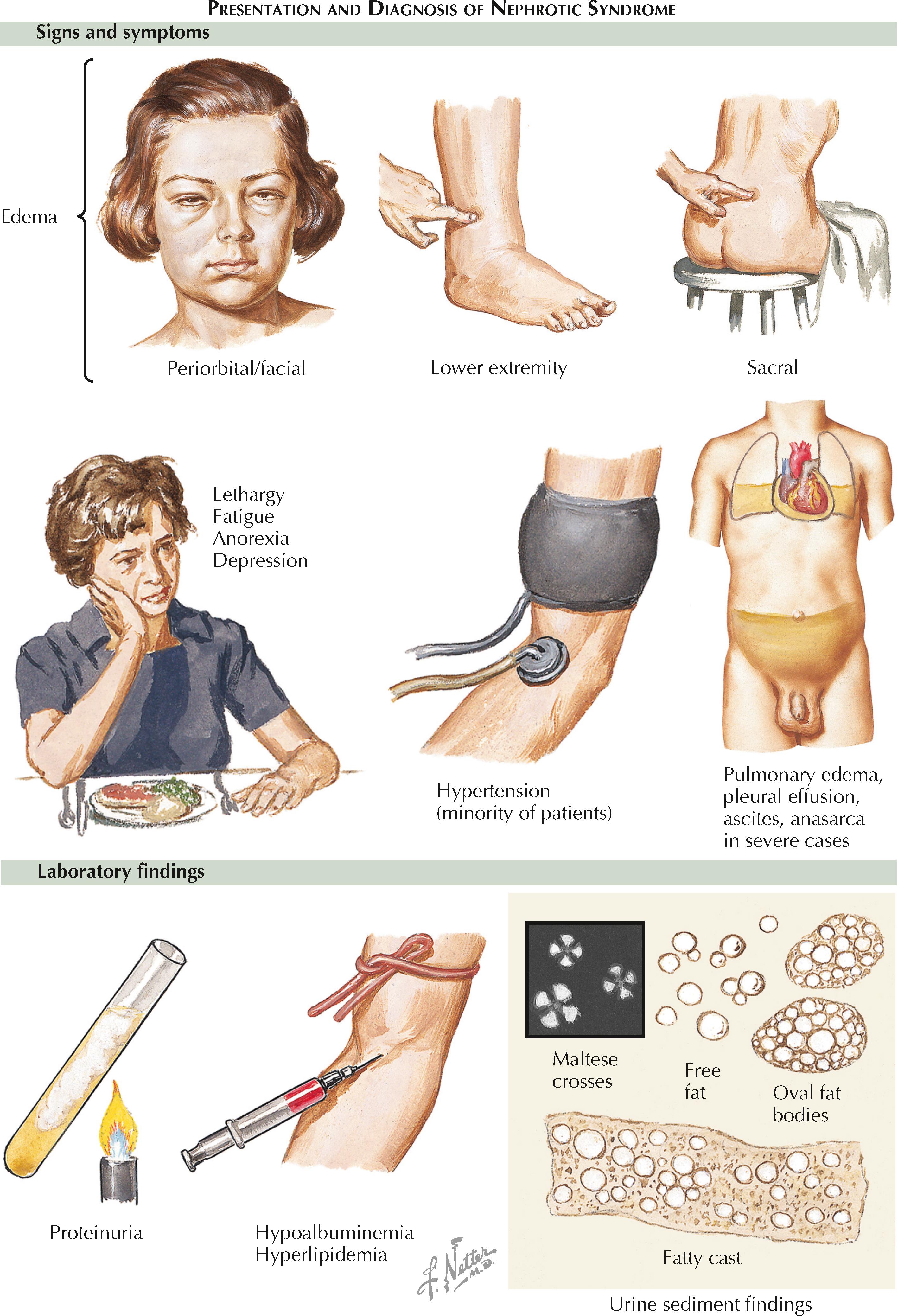
Lifestyle changes are also important. Patients should adopt a low-salt diet to reduce edema and improve blood pressure control. Exercise may help mobilize edema and allow natural diuresis, as well as lower blood pressure and improve cholesterol levels.
Treatment success is defined as reduction or resolution of proteinuria, ideally to less than 300 mg/day, with preserved kidney function. Patients who achieve this endpoint generally have a very favorable prognosis. In contrast, those patients with nephrotic-range proteinuria that do not respond to treatment have a poor overall renal prognosis because ongoing glomerular inflammation will eventually lead to scarring and a permanent loss of renal function.
Minimal change disease (MCD, also known as nil disease and lipoid nephrosis) is the leading cause of nephrotic syndrome in children, accounting for 90% of cases in this population, and a major cause of nephrotic syndrome in adults. In addition to its predilection for children, MCD also occurs more frequently in Asians and Caucasians than in African-Americans.
The name of this disease refers to the seemingly normal appearance of glomeruli when visualized using light microscopy. On electron microscopy, however, diffuse foot process effacement can be seen, which is the basis for the proteinuria.
The vast majority (>85%) of MCD cases are primary, idiopathic phenomena. In the remaining cases, MCD occurs secondary to a systemic insult, such as drugs (e.g., NSAIDs, lithium), neoplasms (especially hematologic malignancies), infections (e.g., tuberculosis, syphilis), and allergies to common irritants (i.e., poison ivy, ragweed, poison oak, bee stings, certain foods).
The precise mechanism of MCD is not known. One theory speculates that dysfunctional T-cells produce a cytokine called the glomerular permeability factor, which injures podocytes (visceral epithelial cells) and leads to foot process effacement. Loss of the slit diaphragm architecture, which constitutes the normal barrier to protein filtration, leads to proteinuria. B cells may also play a role, either by producing the glomerular permeability factor or, alternatively, by secreting an antibody that targets a glomerular antigen.
The immune-mediated hypothesis is supported by the efficacy of immunomodulatory treatments, as well as the fact that MCD may occur secondary to allergens, infections, and cancers of the immune system. In cases of idiopathic MCD, it is not clear what would trigger this abnormal immune response. Some have postulated that viral or bacterial infections may be responsible, although at present there is no evidence for this claim.
Despite the damage to podocytes, the remainder of the glomerulus remains normal. Thus renal function remains intact or is only slightly impaired.
The most common presentation of MCD is the sudden onset of nephrotic syndrome (see Plate 4-7 ). Thus patients typically have substantial edema and the laboratory findings of nephrotic-range proteinuria, hypo albuminemia, and hyperlipidemia. In MCD, the proteinuria tends to be more profound than with other causes of nephrotic syndrome (e.g., > 10 to 15 g/day).
Serum markers of renal function, such as creatinine concentration, are typically normal or only slightly elevated. In a subset of adults, however, acute kidney injury may occur, possibly because of ischemic acute tubular necrosis resulting from massive loss of intra vascular volume. For unclear reasons, adults are also more likely than children to have hypertension and hematuria.
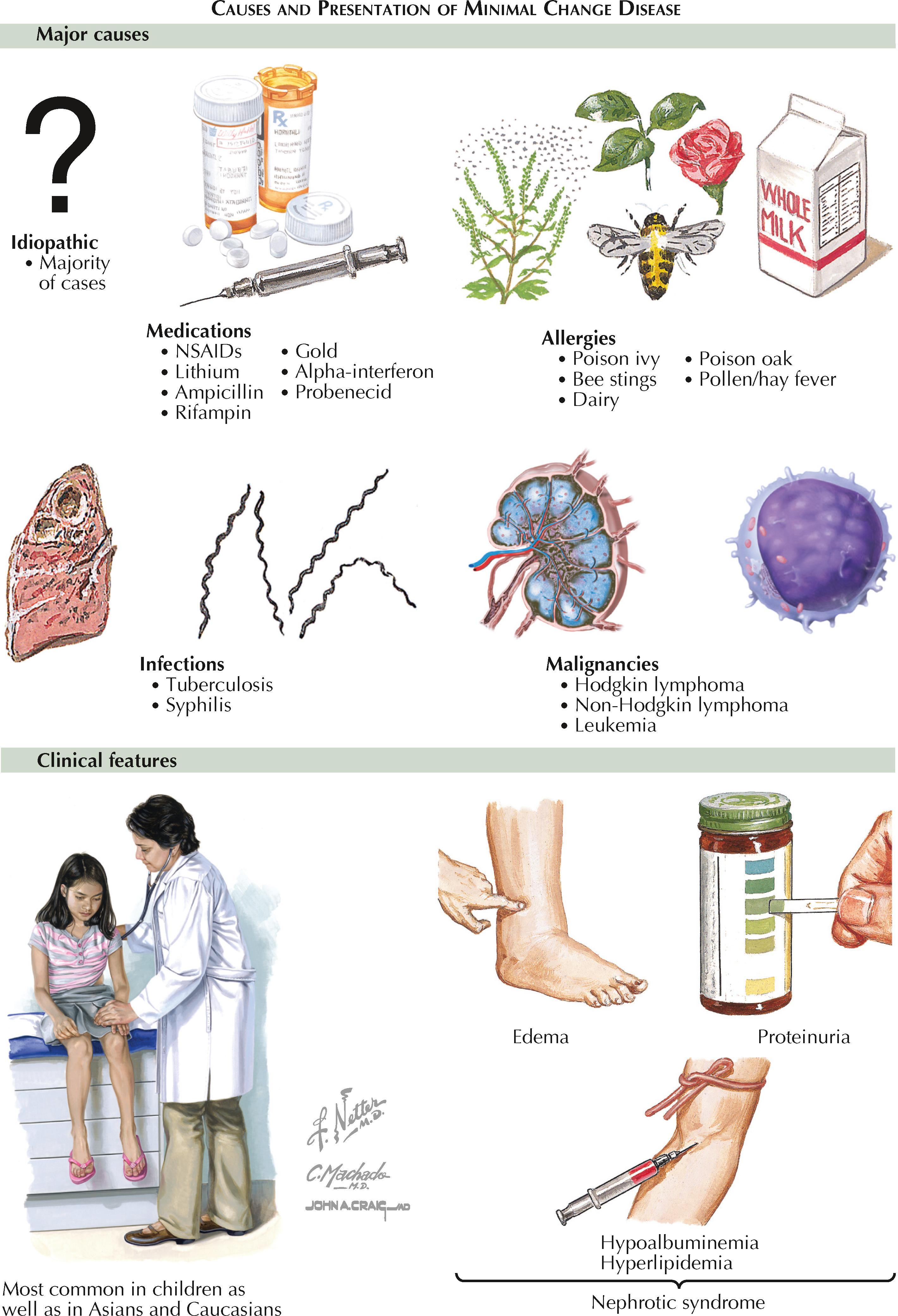
Because patients with MCD tend to have very severe proteinuria, clinicians must be alert for the presence of related complications. As in all cases of nephrotic syndrome, patients are at risk for systemic thromboses. In addition, infection may occur because of multiple factors, including urinary losses of immunoglobulins, alternative complement factor B, and hemolytic factor D. If there is significant edema, the risk of cellulitis increases.
The gold standard for diagnosis of MCD is renal biopsy. In children, however, MCD accounts for such an overwhelming majority of nephrotic syndromes that it is often diagnosed on a presumptive basis, with renal biopsy not performed unless empiric treatment fails. In adults, the differential diagnosis for nephrotic syndrome is very broad, and thus in the absence of a clear underlying cause (such as long-standing diabetes mellitus), renal biopsy is essential for optimization of management.
On light microscopy, the glomeruli generally appear normal. Immunofluorescence is usually unremarkable, although occasional mesangial IgM or complement deposits may be seen. Further examination with electron microscopy, however, reveals diffuse foot process effacement. This finding is not pathognomonic for MCD, however, unless seen in the presence of normal light microscopy findings in an adequate sample size (typically at least 15 glomeruli).
It is important but sometimes challenging to distinguish MCD from FSGS. In some cases, patients diagnosed with MCD fail to respond to treatment and, on repeat biopsy, are found to have FSGS. It is not clear if these cases indicate missampled FSGS in the original biopsy, or a progression of MCD to FSGS due to prolonged periods of heavy proteinuria. Indeed, the relationship between these two entities is poorly understood and controversial; some experts believe that the two entities are on two ends of a continuum.
Once the diagnosis of MCD is established, patients should be screened for the major causes of secondary MCD. If all of these tests are negative or normal, the MCD can be ruled idiopathic.
The primary, idiopathic form of MCD is very responsive to steroids. Up to 95% of patients achieve complete remission, defined as proteinuria declining to levels below 300 mg/day with stable renal function. Among children, half respond within 2 weeks of treatment, and nearly all of the others respond within 8 weeks. Among adults, half respond within 4 weeks of treatment, but the rest may require several months of additional corticosteroids. For as long as the nephrotic syndrome persists, all patients should adopt a low-salt diet, and diuretics should be used as needed for edema control. ACE inhibitors and statins are generally not required in steroid-responsive patients because their disease is short in duration.
Secondary forms of MCD should be treated by focusing on removal or mitigation of the inciting insult, such as discontinuation of a certain drug or treatment of an underlying malignancy.
Patients who experience total remission have a very good long-term prognosis. In contrast, patients with disease that is unresponsive to treatment may experience progressive scarring of glomeruli, with an associated decline in renal function that ultimately leads to end-stage disease.
More than half of adult MCD patients will have a relapse during their lifetime, and up to one in four will become a frequent relapser, experiencing more than three episodes per year. In general, children and adults who go into remission quickly—sometimes within the first week of treatment—are less likely to have subsequent relapses. Because long-term use of steroids has numerous adverse effects, patients with relapsing disease are often prescribed alternative immunomodulatory therapies, such as calcineurin inhibitors, mycophenolate mofetil, and cyclophosphamide.
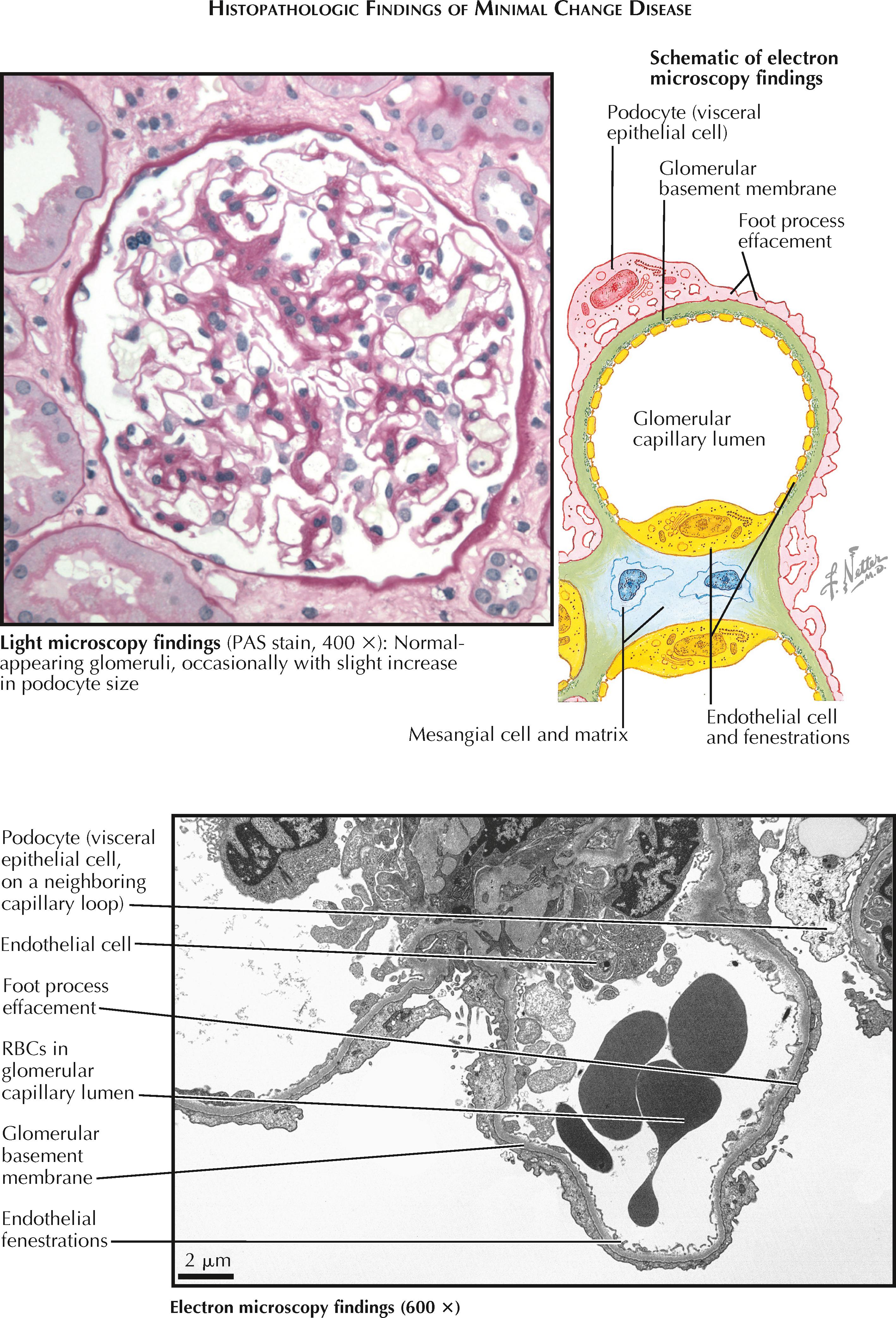
Focal segmental glomerulosclerosis (FSGS) is a clinical-pathologic syndrome in which there is proteinuria accompanied by glomerular scarring or sclerosis that occurs in a focal (i.e., subset of all glomeruli) and segmental (i.e., portion of each affected glomerulus) distribution. FSGS is a major cause of nephrotic syndrome in adults, and it can occur as a primary, idiopathic process or secondary to numerous systemic conditions, including viruses (HIV, parvovirus B19), medications (pamidronate, lithium, alpha interferon), inherited genetic diseases (mutations in podocyte proteins such as α-actinin-4 or podocin), heroin abuse, and any disorder that causes glomerular hyperfiltration (such as morbid obesity or any congenital or acquired reduction in renal parenchymal mass, including renal agenesis, renal dysplasia, renal ablation, diabetic nephropathy, sickle cell anemia, or any advanced chronic kidney disease).
In the United States, FSGS is responsible for more cases of end-stage renal disease (ESRD) than any other primary glomerular disease. Its incidence has increased over past decades, for unknown reasons. It is more common in African Americans than Caucasians, possibly because of inherited genetic factors.
The pathogenesis of FSGS is poorly understood. In primary, idiopathic disease, it appears that a circulating permeability factor is responsible, a hypothesis supported by the fact that FSGS can rapidly recur in a transplanted allograft. Although the exact nature of the glomerular injury remains unknown, it appears probable that podocytes (visceral epithelial cells) are a major target, and that injury or loss of these cells leads to proteinuria and sclerosis.
The pathogenetic bases of secondary FSGS are likely diverse. In HIV-associated FSGS, for example, the virus is thought to directly infect podocytes and disrupt normal regulatory patterns. In hyperfiltration states, increased glomerular pressure is thought to cause progressive endothelial and podocyte injury, ultimately leading to FSGS.
All patients with FSGS have some degree of proteinuria, which may cause the nephrotic syndrome if severe (see Plate 4-7 ). On quantification with a 24-hour collection or spot urine protein : creatinine ratio, the proteinuria may vary from less than 1 to more than 10 g/day. A subset of patients will also be found to have hematuria. Laboratory evaluation of serum may reveal hypoalbuminemia and hypercholesterolemia if the proteinuria is in the nephrotic range. A subset of patients will have renal insufficiency, manifest as an elevated serum creatinine concentration.
The specific diagnosis of FSGS can only be established based on histopathologic findings. Renal biopsy should be performed in adults with nephrotic syndrome in the absence of an apparent cause (i.e., long-standing diabetes mellitus), or in children with unexplained nephrotic syndrome who do not respond to empiric treatment for MCD (see Plate 4-8 ).
Using light microscopy, glomerulosclerosis is seen in a focal and segmental distribution. Segmental occlusion of glomerular capillaries occurs as the end result of several pathologic changes, including hyalinosis (glasslike deposits resulting from subendothelial accumulation of plasma proteins), podocyte swelling, and accumulation of extracellular matrix. Foam cells may be seen trapped within the capillaries of the sclerotic segments. In addition, segmental adhesions may be seen between the sclerotic portions of the glomerular tuft and the adjacent lining of Bowman's capsule.
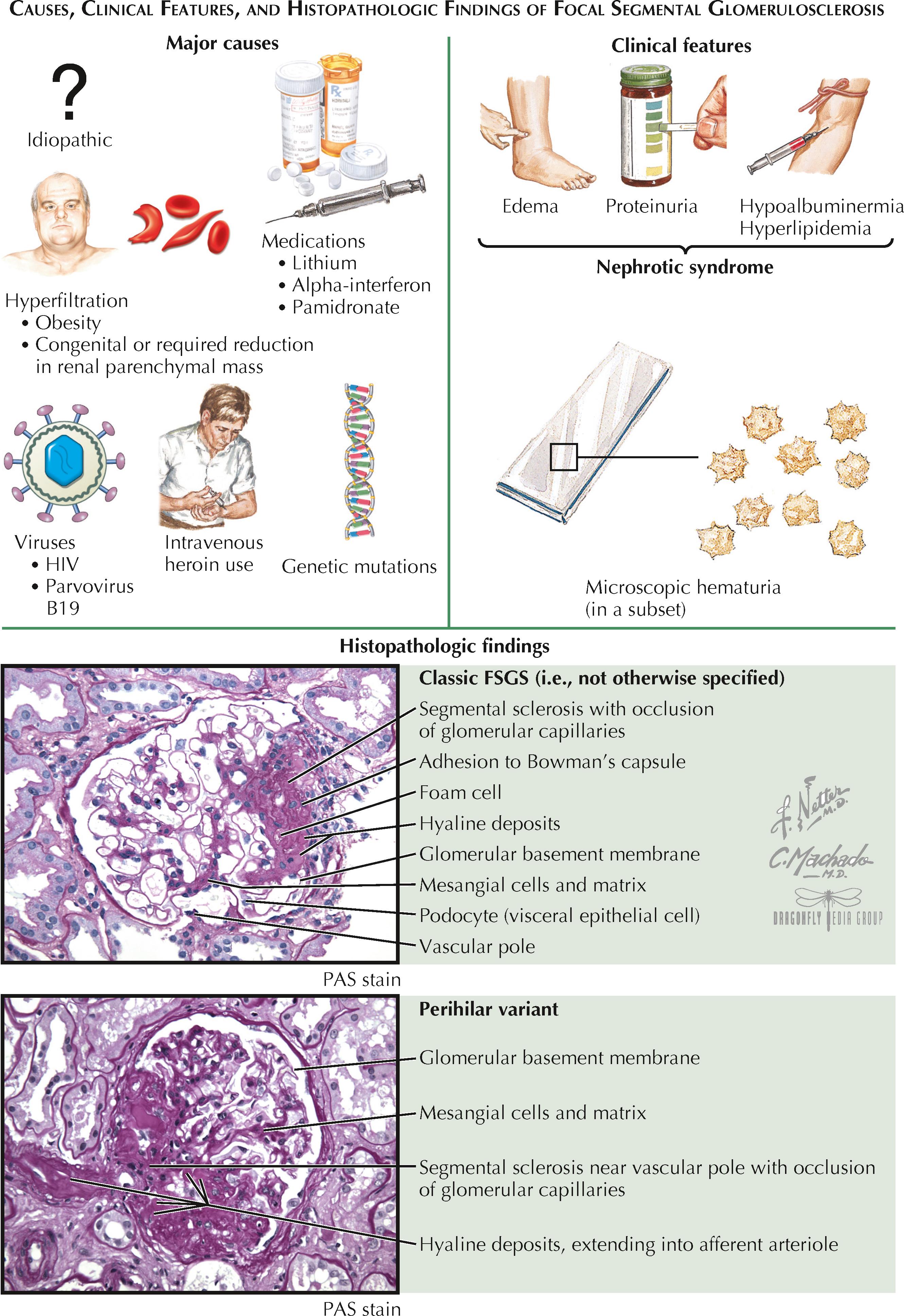
Several histologic variants of FSGS can be distinguished, including classic FSGS (also known as FSGS not otherwise specified), perihilar variant, glomerular tip variant, cellular variant, and collapsing variant. It is unclear if these different subtypes have different pathophysiologic bases or merely represent different degrees of glomerular damage.
The perihilar variant of FSGS is characterized by the presence of perihilar hyalinosis and sclerosis in >50% of affected glomeruli. This variant can be seen in primary disease; however, if seen in the presence of glomerulomegaly, it suggests a secondary form related to glomerular hyperfiltration. The glomerular tip variant is characterized by a focal lesion localized near the urinary pole of Bowman's capsule, where the proximal tubule begins. The capillary lumina in this region appear obliterated secondary to the presence of foam cells and swollen endothelial cells, whereas the overlying podocytes appear hypertrophic and confluent with adjacent parietal and tubular epithelial cells. Adhesions may be seen between the glomerular tuft and the urinary pole. The cellular variant is characterized by the presence of segmental endocapillary hypercellularity in at least one glomerulus that affects at least 25% of the tuft and results in occlusion of the capillary lumina. The infiltration of leukocytes, foam cells, and other cell types may result in karyorrhexis and other evidence of active inflammation. The collapsing variant is characterized by a segmental or global collapse of glomerular capillaries with significant hypertrophy and hyperplasia of overlying podocytes, which often contain large intracytoplasmic protein resorption droplets. Unlike in other FSGS variants, hyalinosis and foam cells are generally not seen. This variant may occur as a primary phenomenon but is also the characteristic lesion of HIV-associated nephropathy (see Plate 4-55 ).
On immunofluorescence, all types may reveal irregular positive staining for immunoglobulin M and complement factor C3 in the same focal, segmental distribution as the glomerulosclerosis. Strongly positive staining for antibodies or complement proteins in nonsclerotic glomeruli suggests an underlying immune complex glomerulonephritis. Electron microscopy of the sclerotic lesions in all subtypes reveals wrinkling and retraction of the glomerular basement membrane (GBM), subendothelial accumulation of hyaline material, diffuse foot process effacement, podocyte hypertrophy, and focal areas of podocyte detachment from the GBM.
If FSGS is diagnosed, patients should be screened for secondary causes that may otherwise be subclinical, such as HIV infection.
All patients with FSGS (both primary and secondary forms) should receive angiotensin-converting enzyme (ACE) inhibitors or aldosterone receptor blockers (ARBs) to reduce proteinuria and slow the progression to end-stage renal disease (ESRD). Hyperlipidemia, if present, should be treated with a cholesterol-lowering medication, such as a statin. Patients with edema may require diuretic therapy and should be encouraged to adopt a low-salt diet. Blood pressure should be aggressively controlled.
In cases of primary FSGS with subnephrotic pro teinuria, the above conservative measures are often adequate. In cases with nephrotic syndrome, immunosuppression is warranted. Initial treatment is with high dose glucocorticoids for up to 6 months. About half of patients attain either full remission (<300 mg/day of proteinuria) or partial remission (reduction in nephrotic rage proteinuria by > 50%) with glucocorticoids. For those patients who do not achieve remission, or who experience relapsing disease, cyclosporine or tacrolimus (both calcineurin inhibitors) can be used as second line agents as long as renal function is relatively intact.
In cases of secondary FSGS, treatment should focus on reversing the underlying cause, which may slow down or halt progression of the renal disease.
Overall, idiopathic FSGS has a significantly higher rate of progression to ESRD than secondary forms. The clinical features that portend a poor prognosis include high levels of proteinuria (particularly if associated with nephrotic syndrome), impaired renal function, and failure to achieve remission (either complete or partial). The pathologic features that portend a poor prognosis include collapsing variant and high levels of interstitial fibrosis. In contrast, the glomerular tip variant confers a more favorable prognosis, with a higher likelihood of attaining disease remission with steroids.
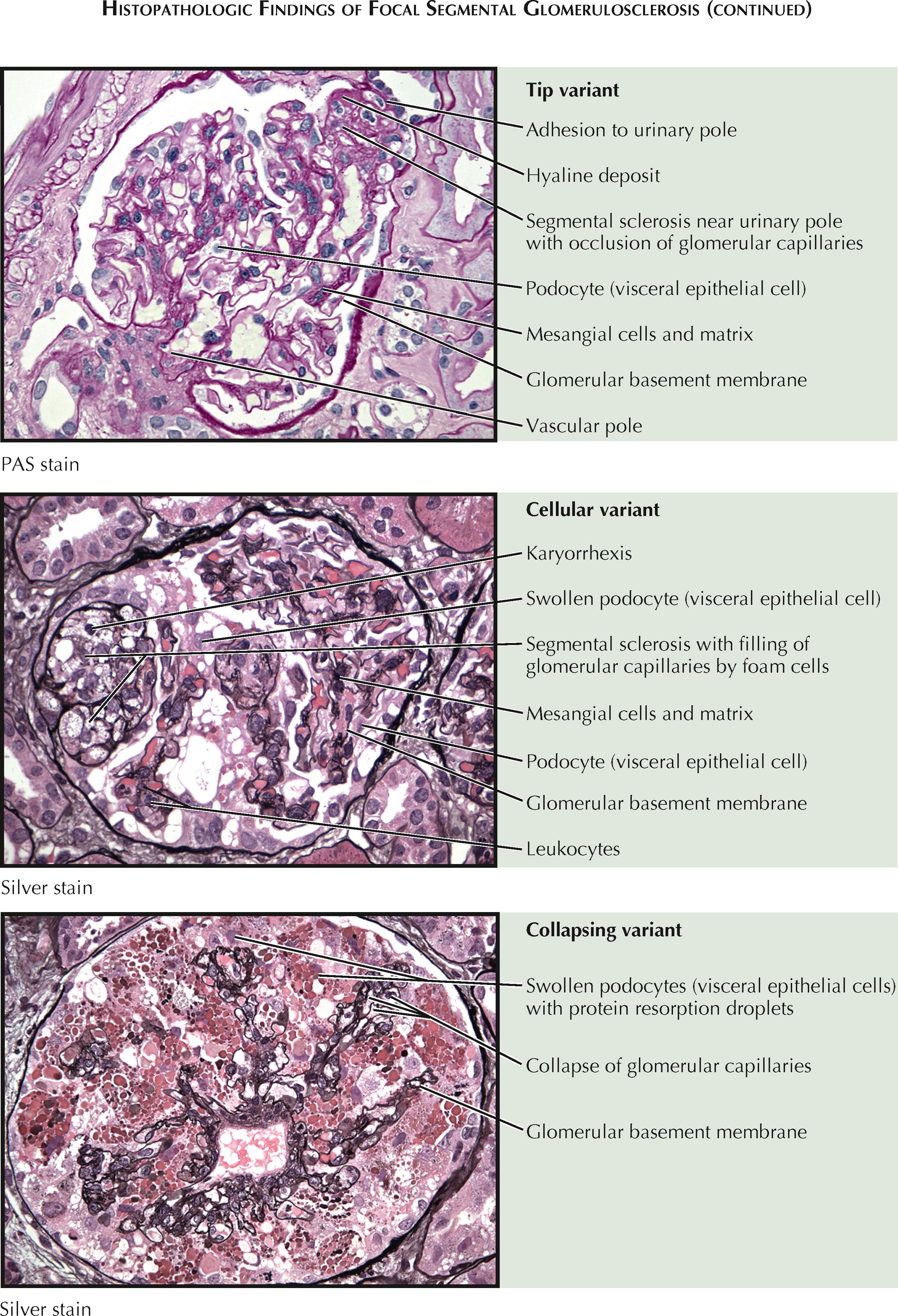
If appropriate treatment is not provided, a significant portion of patients with primary FSGS will progress to ESRD. Only a small minority of patients experience complete spontaneous remission. Patients who progress to end-stage renal disease and receive a renal transplant are at risk for recurrent FSGS in the allograft.
C1q nephropathy is a rare but distinct cause of nephrotic syndrome with a clinical presentation and histopathologic findings that are very similar to what is seen with FSGS. Like FSGS, C1q nephropathy is also more common among African Americans. The pathogenesis is unknown but is likely immune-mediated. The major feature that distinguishes C1q nephropathy from FSGS is the presence of mesangial immune complex deposits that stain positive for C1q on immunofluorescence. Staining is often positive for IgG, IgM, and C3 as well. There is no established treatment for C1q nephropathy. Some clinicians advise steroids, although the literature has offered mixed results regarding its efficacy.
Membranous nephropathy (MN) is one of the most common causes of nephrotic syndrome in adults. It is named for the major histologic finding of diffuse glomerular basement membrane (GBM) thickening. The epidemiology and overall incidence of this disease has remained constant over several decades, with a peak incidence between 30 and 50 years of age.
In most cases MN is a primary phenomenon. About one quarter of cases, however, occur secondary to systemic diseases or infections. The major causes include systemic lupus erythematosus (SLE), rheumatoid arthritis, Sjögren syndrome, Hashimoto thyroiditis, viral hepatitis infection (hepatitis B and, less commonly, hepatitis C), hematopoietic stem cell transplantation, and solid tumors (e.g., lung, colon, breast, kidney carcinomas). Some medications—such as gold, penicillamine, NSAIDs, and antitumor necrosis factor agents—have also been implicated.
Primary MN occurs when circulating antibodies permeate the GBM and form immune complexes with epitopes on podocyte membranes. Although lymphocytes do not have access to this space, formation of complement C5b-C9 membrane attack complexes inflicts significant damage on podocytes. As a result, foot process effacement occurs, and the glomerular capillary walls are no longer capable of excluding proteins from the urinary space. In addition, the damaged podocytes secrete additional extracellular material that leads to expansion of the GBM.
For several decades, the specific podocyte epitope responsible for the above processes was unknown. During this time, however, it was discovered that antibodies targeting megalin, a podocyte membrane protein, produced a nearly identical disease in rats known as Heymann nephritis. Although this finding offered insights into the basic mechanism for MN, it did not clarify the relevant epitope in humans because megalin is not expressed on human podocytes.
More recent research, however, identified the M-type phospholipase A2 receptor (PLA2R), found on the surface of podocytes, as a major antigen in primary MN. In one series, antibodies targeting this transmembrane protein were identified in approximately 70% of patients with primary MN. In contrast, these antibodies were not identified in patients with secondary MN or healthy controls.
Secondary MN appears to result from subepithelial deposits of circulating immune complexes. Presumably, the antigens involved in the various disease states that cause secondary MN—double-stranded DNA in SLE; hepatitis B antigen; carcinoembryonic antigen, prostate specific antigen, and many others in malignancy; thyroglobulin in thyroiditis; treponemal antigen, and many others in syphilis—spur formation of immune complexes, which deposit in the glomerulus. In secondary MN these immune complexes are found in the subepithelial space, which leads to podocyte injury. Unlike in primary MN, however, immune complexes may also deposit in the mesangium and extraglomerular sites.
The classic presentation of MN is nephrotic syndrome (see Plate 4-7 ) with an insidious onset. Patients typically describe slowly progressive lower extremity edema that, in some cases, has advanced to overt anasarca. Laboratory examination of serum and urine reveals proteinuria, hypoalbuminemia, and hyperlipidemia. Renal function, as inferred from serum creatinine concentration, is usually intact. The degree of proteinuria in MN patients is variable, ranging from subnephrotic (i.e., less than 3.5 g/day) to more than 20 g/day. Some patients may have completely asymptomatic proteinuria.
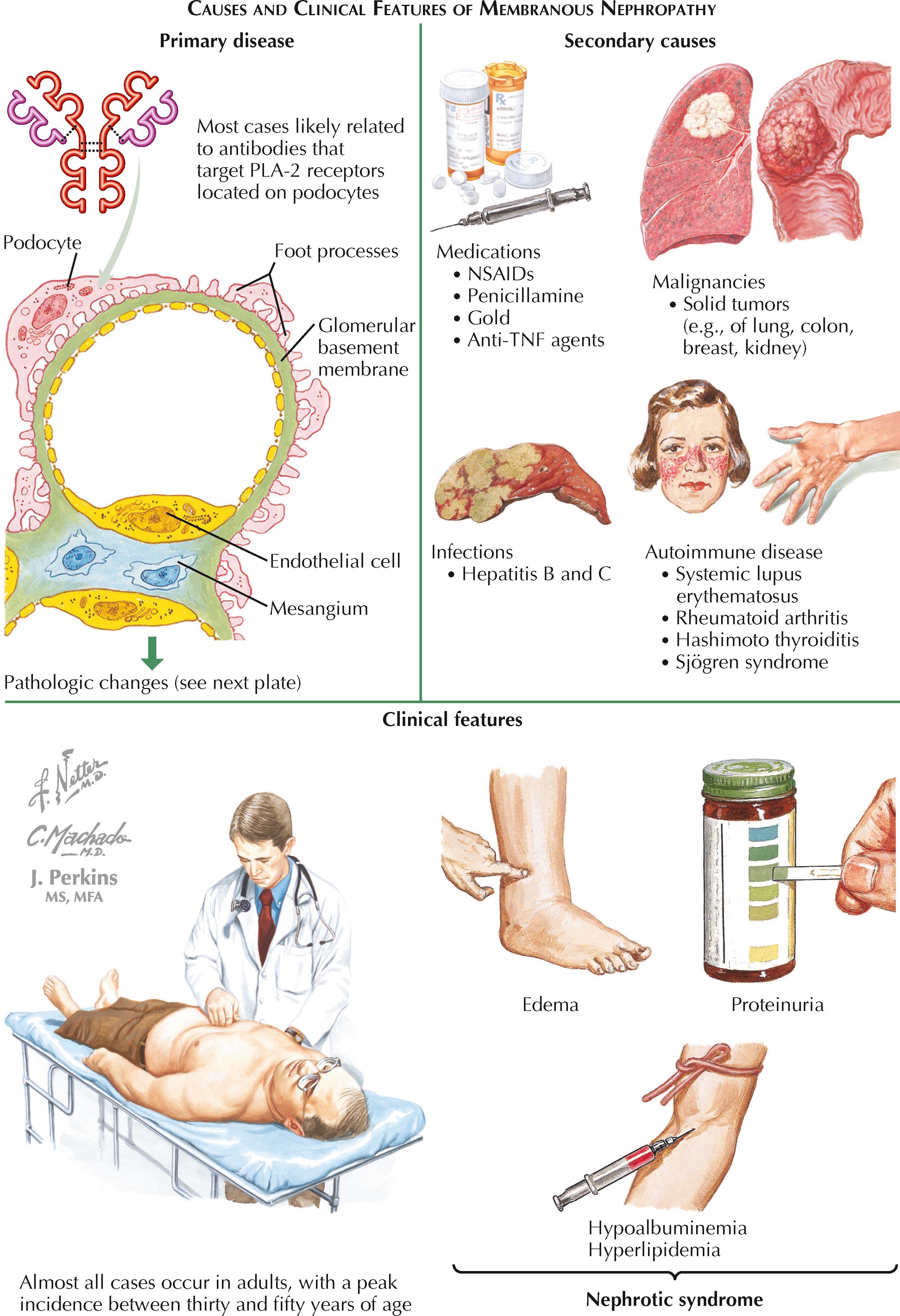
Patients with MN are at increased risk of renal vein thrombosis, even among other patients with nephrotic syndrome. This complication affects up to one in five patients in some series. In general, the heavier the proteinuria and lower the serum albumin, the higher the risk for thrombotic complications.
MN can only be diagnosed based on histopathologic findings. Thus in adults with unexplained nephrotic syndrome, renal biopsy must be performed. In MN, light microscopy reveals diffuse GBM thickening, which is especially prominent with silver stains. The pathogenetic immune complexes are not visible at this resolution; however, the growing GBM forms “spikes” between these complexes, which may be seen instead. In primary MN there are generally no cellular infiltrates, since the immune complexes form in the subepithelium and are thus protected from the circulation. In secondary MN, however, infiltrates may occur because circulating immune complexes also deposit in the mesangium.
Immunofluorescence reveals diffuse granular staining for IgG and C3 along the GBM. Using electron microscopy, effacement of podocyte foot processes may be seen. In addition, the subepithelial immune complexes are visible as electron-dense deposits. These are limited to the subepithelium in primary MN but may also be visible in the mesangium in secondary disease. The presence of endothelial tubulo-reticular inclusions suggests SLE-related disease.
If biopsy confirms MN, patients should be evaluated for the most common causes of secondary disease, especially if there are also suggestive histologic findings. The most important laboratory tests include antinuclear and anti-dsDNA antibodies for SLE; hepatitis B and C serologies; and rapid plasma reagin screening for syphilis. In addition, all patients above the age of 40 with confirmed MN should undergo screening for malignancies because the incidence is about 5% to 10% in this population, rising as high as 20% in patients over 60 years old. Even patients with a negative initial workup should continue to undergo surveillance because malignancies may not appear until months or even years after the onset of nephrotic syndrome.
All patients should be placed on a renin-angiotensin system blocker (e.g., ACE inhibitor) and cholesterol-lowering medication, such as a statin, for as long as the proteinuria continues. Edema can be treated as needed with diuretic therapy, and all patients should be encouraged to adopt a low-salt diet.
In idiopathic MN, the need for immunosuppression depends on the risk of disease progression. Patients with subnephrotic proteinuria, for example, often ex perience spontaneous remission and should there-fore receive only the conservative treatments listed above.
Patients with very heavy proteinuria (more than 8 to 9 g/day), in contrast, will likely develop progres-sive chronic kidney disease if they do not receive immunosuppressive agents. Patients with intermediary proteinuria (between 3.5 to 8 g/day) should receive immunosuppressive agents if proteinuria does not fall below 3.5 g/day after 6 months of conservative management.
Several immunosuppressive agents may be used to treat primary MN. The two leading therapies are alkylating agents (cyclophosphamide or chlorambucil) and calcineurin inhibitors (cyclosporine or tacrolimus), either of which is given in combination with oral or intravenous corticosteroids. Recently, other agents such as rituximab, ACTH, and mycophenolate mofetil have also shown promising results, particularly in cases refractory to initial therapeutic attempts.
In secondary MN, treatment centers on removal of the underlying cause, after which there is often a complete remission of proteinuria within several months.
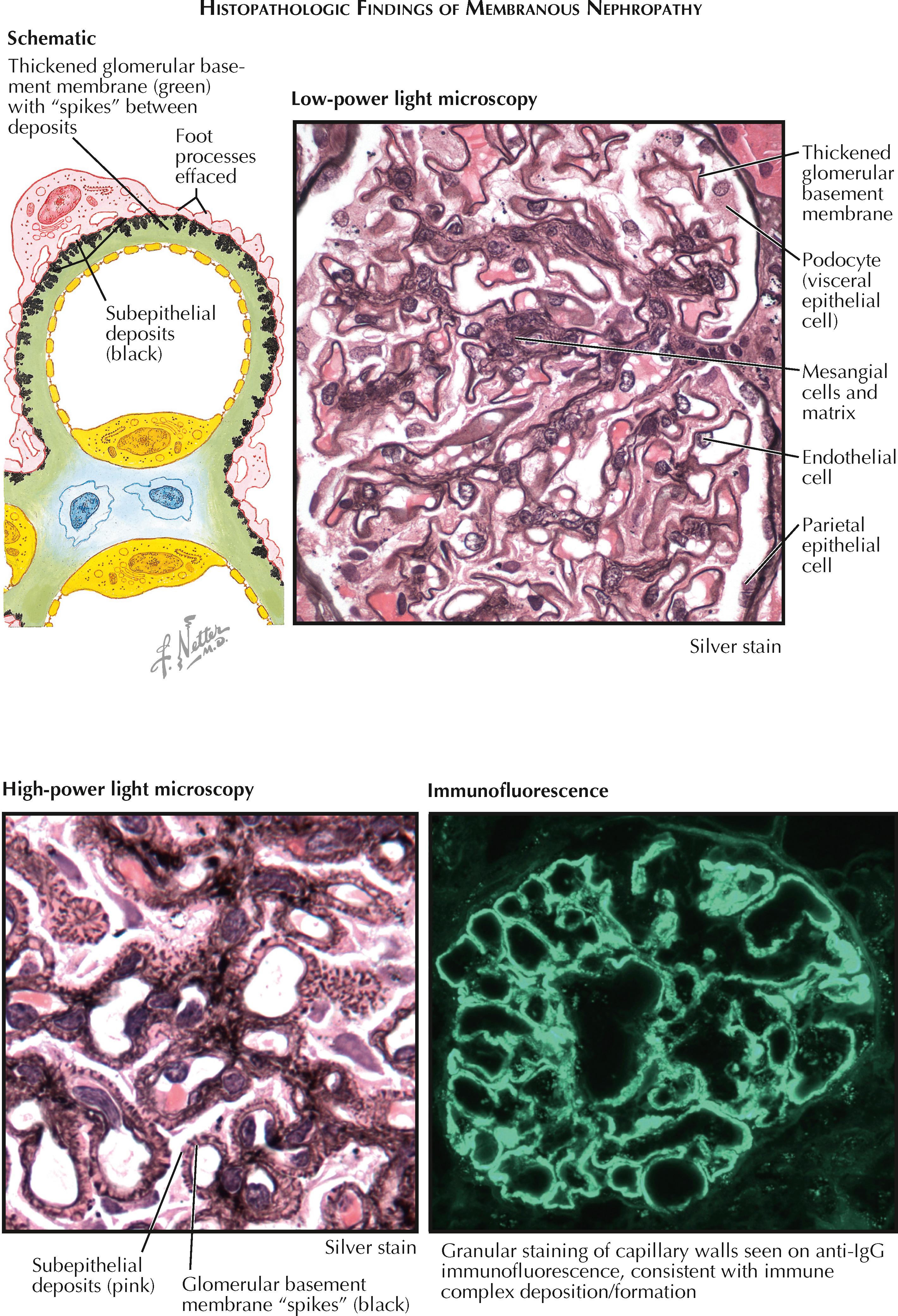
Patients with idiopathic MN who experience either spontaneous or drug-induced remission have an excellent prognosis, and the majority of patients who receive immunosuppression achieve complete or partial remission. Relapse, however, occurs in up to 30%, requiring repeat rounds of immunosuppression.
The patients who do not achieve long-term remission may experience a progressive, sometimes rapid, decline in renal function that can progress to ESRD. If a transplant is performed, the risk of MN recurring in the allograft is approximately 10% to 15%.
Glomerulonephritis (GN) is a general term used to indicate glomerular inflammation, which may occur secondary to many different disease processes. The specific pattern of inflammation, as dictated by the underlying process, generally determines the major signs and symptoms, which may include microscopic or gross hematuria, proteinuria, hypertension, edema, and/or renal insufficiency.
Glomerulonephritis may present as any of the following clinical syndromes:
Adults with IgA nephropathy (see Plate 4-16 ) often present in this manner. Their urinary abnormalities are commonly discovered on routine physical examination and urine dipstick.
Children with IgA nephropathy often present in this manner, developing gross hematuria several days after an upper respiratory infection (“synpharyngitic nephritis”).
Patients have “nephritic syndrome,” which includes variable degrees of renal insufficiency; oliguria; hypertension; edema; proteinuria; and gross or microscopic hematuria. Poststreptococcal GN ( Plate 4-19 ), membranoproliferative GN ( Plate 4-22 ), and lupus nephritis ( Plate 4-49 ) often present in this manner.
Patients experience a rapid deterioration of renal function over days, weeks, or months that invariably progresses to end-stage renal disease (ESRD) if untreated. Any form of glomerulonephritis may cause RPGN, although vasculitic glomerulonephritis and antiglomerular basement membrane disease frequently cause this severe phenotype.
Patients have minimal symptoms and are often discovered to have hypertension, renal impairment, and proteinuria on routine physical examination and laboratory assessment. IgA nephropathy frequently presents in this manner after years of preceding asymptomatic hematuria/proteinuria, which may have gone unnoticed.
Glomerulonephritis should be suspected in any patient with one of the above clinical presentations. Proteinuria should be quantified using either a 24-hour collection or, more often, a spot urine protein : creatinine ratio. Glomerular hematuria can be distinguished from other causes of urinary tract bleeding by the presence of either dysmorphic red blood cells (RBCs) or RBC casts on urine microscopy. RBCs become dysmorphic upon passing through the damaged GBM. An acanthocyte, characterized by its protruding blebs, is an example of a dysmorphic RBC. A large number of dysmorphic RBCs (often defined as 50% to 80% of RBCs seen on urine microscopy) indicates glomerular bleeding. Meanwhile, some of the RBCs in the tubules become bound together by the Tamm-Horsfall mucoprotein, forming RBC casts, which are thus also characteristic of glomerular bleeding.
The different causes of glomerulonephritis are distinguished based on history, clinical findings, serologic tests, and renal biopsy findings. The characteristic features of each disease process are described later in this section. Some general terms, however, are often used to describe the patterns of glomerular inflammation seen on light microscopy and immunofluorescence.
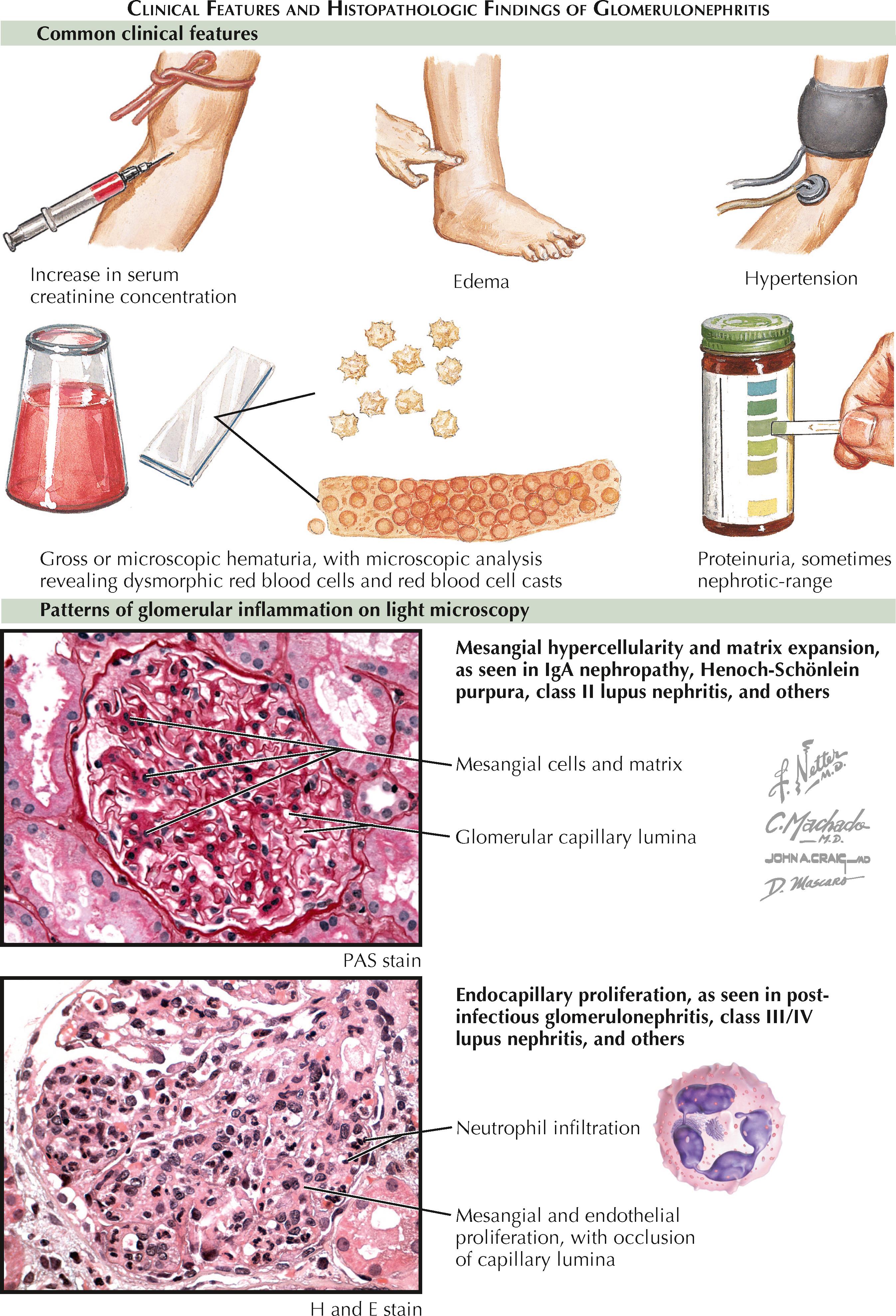
With light microscopy, the pattern of glomerular inflammation is often described as mesangial, endocapillary, and/or extracapillary (crescentic); focal or diffuse; and segmental or global.
Inflammation can occur in several different regions of the glomerulus, leading to characteristic structural changes.
Mesangial involvement can manifest as mesangial hypercellularity (defined as more than three mesangial cells per mesangial area) and/or mesangial matrix expansion. These structural changes are often associated with microscopic hematuria and/or mild proteinuria, with preservation of normal filtration function. Common causes include IgA nephropathy and class II lupus nephritis.
Endocapillary involvement can manifest as occlusion of glomerular capillaries by endothelial and mesangial cell proliferation, as well as by leukocyte infiltration. These changes are often associated with hematuria, proteinuria, and reduction of filtration function. Common causes include postinfectious GN and class III or IV lupus nephritis.
Extracapillary involvement, more commonly known as crescentic disease, manifests as thickening of the parietal epithelium of Bowman's capsule to more than two cell layers, which causes it to resemble a crescent. The formation of such crescents occurs secondary to the rupture of glomerular capillaries, which permits cells and proteins to leak into and accumulate along Bowman's space. Cellular crescents are the defining lesion of rapidly-progressive glomerulonephritis (RPGN, see Plate 4-25 ).
In focal GN, fewer than half of the glomeruli appear abnormal. Common causes of focal disease include IgA nephropathy and class III lupus nephritis.
In diffuse GN, more than half of the glomeruli appear abnormal. Common causes include postinfectious GN, class IV lupus nephritis, and membranoproliferative GN.
In segmental lesions, fewer than half of the capillaries within most affected glomerular tufts appear abnormal. In global lesions, more than half of the capillaries within most affected glomerular tufts appear abnormal.
The pattern observed on immunofluorescent staining of the glomerulus for antibodies and/or complement proteins can often be described as granular, linear, or pauci-immune. These patterns offer clues into the underlying disease process.
A pattern of patchy, granular staining for antibodies and complement proteins suggests immune complex deposition. The deposited complexes fix complement, leading to direct complement-mediated damage and, frequently, endocapillary proliferation.
IgA nephropathy is the most common cause of immune complex GN and the most common cause of GN in general. Other causes of immune complex GN include lupus nephritis, membranoproliferative GN, and postinfectious GN. These diseases are typically associated with depressed complement levels, reflecting their mechanism of inflammation; however, complement levels may remain normal in IgA nephropathy because of the slow rate at which the various components are consumed.
A pattern of continuous, linear staining for antibodies and complement proteins along the capillary walls suggests direct binding of antibodies to the glomerular basement membrane (GBM). Such binding occurs in the anti-GBM diseases, in which autoantibodies form against the noncollagenous 1 (NC1) domain of the α-3 chain of type IV collagen (α-3 IV). The resulting inflammation almost invariably leads to RPGN.
In the spectrum of anti-GBM disease, one third of patients have renal-limited disease, whereas the remainder have the combined pulmonary-renal syndrome named for Goodpasture. Goodpasture syndrome occurs when the anti-GBM autoantibodies bind to the alveolar basement membrane, causing pulmonary hemorrhage. This syndrome occurs almost exclusively in smokers and others exposed to hydrocarbons, suggesting that environmental factors play a key role in determining the susceptibility of the pulmonary capillaries to circulating anti-GBM autoantibodies.
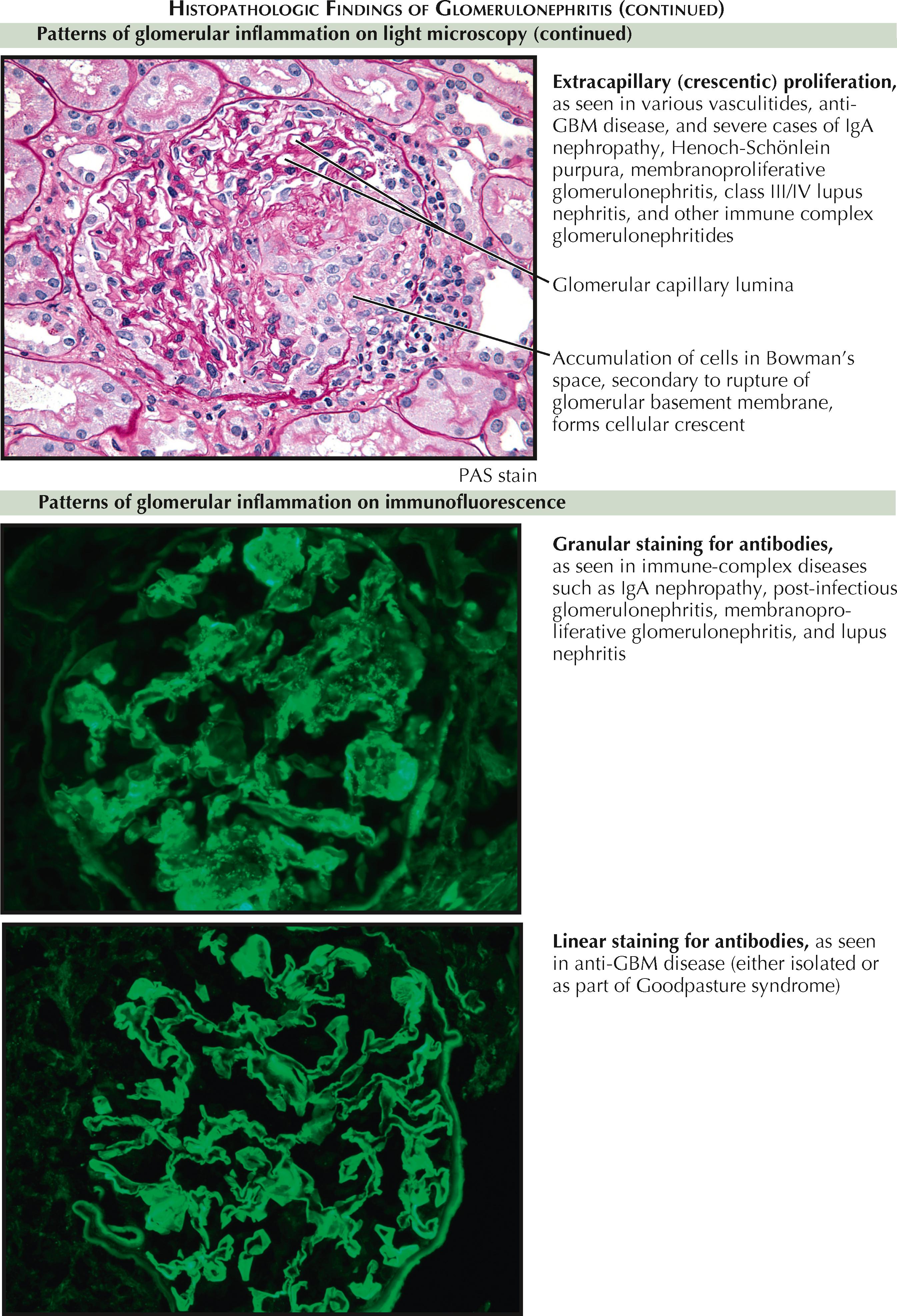
A general lack (or, as the name suggests, paucity) of staining for antibodies or complement proteins suggests vasculitic GN. In such cases, inflammation generally reflects the presence of circulating antineutrophil cytoplasmic antibodies (ANCAs), which are believed to directly activate neutrophils. The ensuing glomerular inflammation often leads to RPGN, and it may be either isolated or part of a systemic vasculitis. Other common histologic findings include fibrinoid glomerular necrosis, periglomerular inflammation, and arteritis.
ANCAs can be subdivided into those with a cyto plasmic staining pattern (c-ANCA) and those with a perinuclear staining pattern (p-ANCA). c-ANCAs almost always target proteinase-3 antigens (PR3-ANCA) and are often associated with Wegener granulomatosis. p-ANCAs almost always target myeloperoxidase antigens (MPO-ANCA) and are often associated with Churg-Strauss disease and microscopic polyangiitis. The ANCA-positive systemic vasculitides all feature a propensity toward multiple organ involvement. Specifically, Wegener granulomatosis and microscopic polyangiitis are associated with pulmonary hemorrhage, whereas Churg-Strauss features asthma and eosinophilia.
IgA nephropathy (IgAN; also known as Berger disease) is the most common primary glomerular disease worldwide. IgAN can occur as a primary renal phenomenon or secondary to various extrarenal conditions, including chronic hepatic disease (especially alcoholic cirrhosis), celiac disease, HIV, inflammatory bowel disease, and others. In addition, an identical renal disease may occur as part of the systemic vasculitis seen in Henoch-Schönlein purpura (see Plate 4-61 ).
The frequency of IgAN in a renal biopsy series ranges from 5% to 10% in the United States to 35% in Asian countries. IgAN may occur at any age but is usually diagnosed in young adults, with a male : female ratio of at least 2 : 1. The clinical manifestations are diverse and can include asymptomatic hematuria and proteinuria, gross hematuria, nephrotic syndrome, and acute kidney injury. In up to one in three patients, IgAN will progress to end-stage renal disease.
In IgAN, glomerular injury occurs when polymeric IgA1 molecules (i.e., two or more IgA1 antibodies joined by a J chain protein) deposit in the mesangium, resulting in a variable degree of glomerular hyper cellularity and sclerosis.
In some patients, primary IgAN manifests as episodes of gross hematuria within 1 or 2 days of a mucosal infection. Thus it was once believed that this condition resulted from overstimulation of the mucosal immune system, which is the main site of IgA synthesis in normal individuals. Subsequent investigation, however, revealed that mucosal plasma cells actually have a decreased level of IgA production in the setting of IgAN. Instead, there is an increased number of active IgA-specific plasma cells in the systemic circulation and bone marrow. Therefore, although mucosal infections may precipitate abnormal IgA production, the polymeric IgA1 deposits derive from an abnormal systemic immune response. This process may reflect a defect in T-cell control of IgA production.
A mere increase in the production of IgA, however, is still inadequate to explain disease formation. For example, patients with myeloma or AIDS often have a significant increase in IgA levels without concomitant IgAN. Instead, it appears that the IgA molecules responsible for renal disease possess unique features that promote their accumulation within mesangial cells. In particular, there appears to be a reduced degree of glycosylation at the hinge region O-glycans, which may reflect reduced function of the enzyme β-1,3-galatosyltransferase in IgA-producing B cells. Recent studies suggest that defective IgA1 glycosylation may be an inherited risk factor.
These structural changes in the IgA molecule appear to promote mesangial deposition through multiple mechanisms, although the details are still unclear. First, the fact that the IgA molecules are in polymeric form may promote some nonspecific, size-based trapping. Second, the altered glycosylation appears to increase the affinity for mesangial extracellular matrix components, such as type IV collagen. Third, it appears that specific mesangial receptors normally bind to and clear IgA from the circulation, and that the structural changes in the IgA molecule may interfere with this process and lead to IgA accumulation. Finally, the modified IgA molecules also undergo slower systemic clearance, further promoting their accumulation.
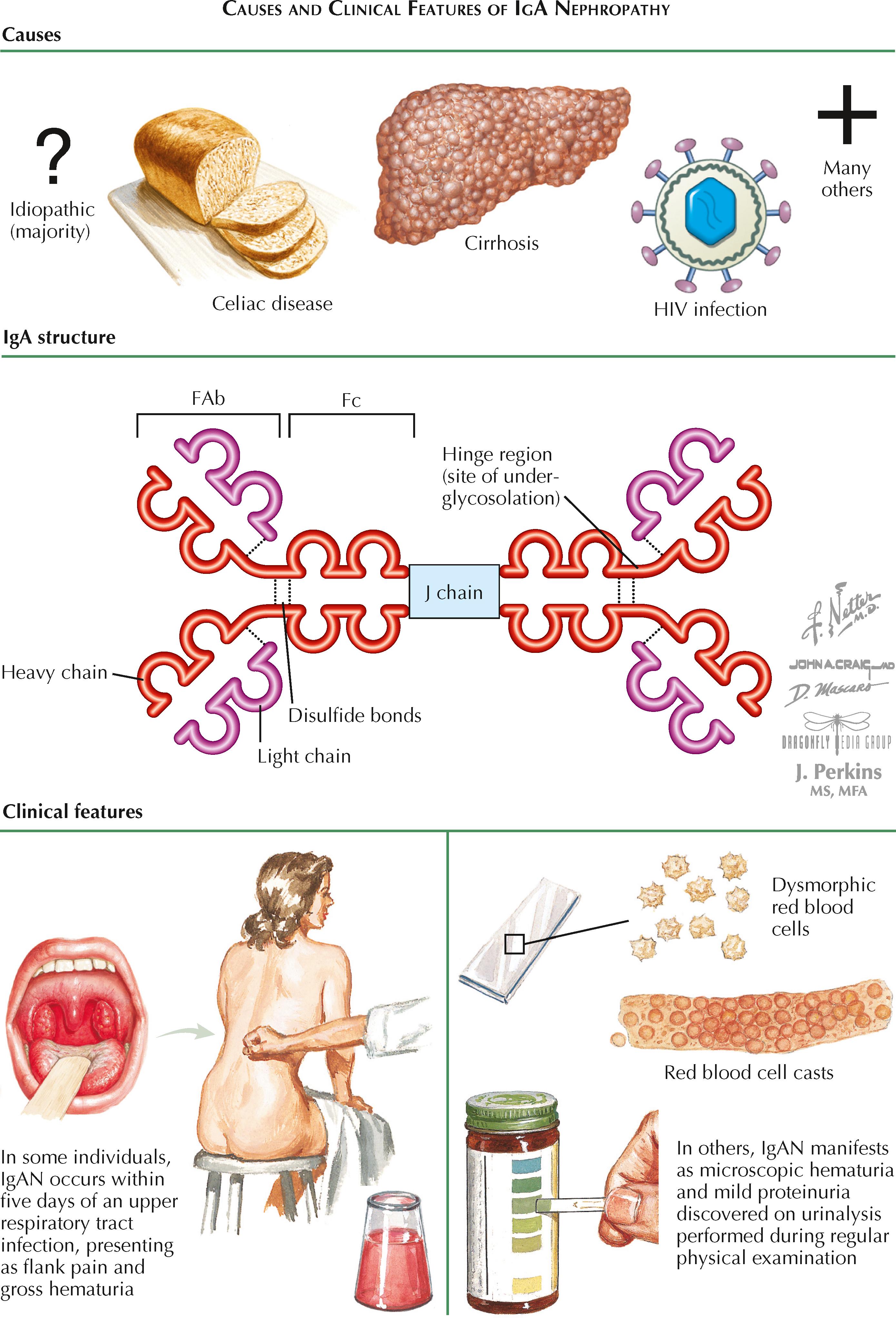
Once IgA binds to the mesangium, it may stimulate mesangial cell proliferation and trigger mesangial cell release of proinflammatory mediators, such as interleukin 6 and TNF-α, as well as profibrogenic mediators, such as PDGF-β and TGF-β. In addition, IgA appears to activate complement via the alternate pathway and the mannose-binding lectin (MBL) pathway. In normal circumstances, MBL activates complement when its carbohydrate recognition domain (CRD) binds to mannose residues on pathogen surfaces. In IgAN, it is possible that the CRD recognizes the abnormally glycosylated region of the IgA molecule itself. Finally, IgG may target regions of the IgA molecule and promote further inflammation.
Not all IgA that binds to the mesangium, however, is capable of generating disease. In fact, in some series up to 5% to 15% of otherwise healthy individuals are found to have glomerular IgA deposition. The specific changes in IgA that allow it to provoke inflammation after mesangial deposition, as well as the genetic features that underpin these changes, have not been identified.
Secondary IgAN may reflect either overproduction or reduced clearance of IgA. The role of abnormal glycosylation has not been adequately studied. The most common cause of secondary IgAN is chronic liver disease, which causes reduced IgA clearance. Other conditions, such as celiac disease and HIV infection, may act by increasing the levels of circulating IgA antibodies. Even in these settings, a majority of the patients found to have glomerular IgA deposits have no clinical signs of IgAN, underscoring that IgA-mesangial interactions are important for triggering pathologic changes.
The clinical presentation of primary IgAN is variable. In about half of patients, especially those under 40 years of age, the disease presents as episodes of gross isolated hematuria and flank pain that occur within a few days of an upper respiratory tract infection (either bacterial or viral). These episodes are sometimes termed “synpharyngitic nephritis.” The latency period is shorter than in poststreptococcal glomerulonephritis (see Plate 4-19 ), which tends to occur about 10 days after infection.
In about 40% of patients, and more commonly in adults, IgAN presents as microscopic hematuria and mild proteinuria (less than 2 g/day), which is detected on routine urinalysis. In 10% of patients, the proteinuria is severe enough to cause nephrotic syndrome. About 25% of patients have hypertension at the time of diagnosis, and another 25% develop hypertension over time. The age-related differences in clinical features are consistent with the existence of multiple different underlying pathogenetic mechanisms in IgAN.
In a majority of cases, serum creatinine and other markers of renal function are normal. In 5% to 10% of cases, however, acute kidney injury (AKI) occurs, reflecting either tubular obstruction by erythrocytes or fulminant disease, such as rapidly progressive glomerulonephritis (see Plate 4-25 ). AKI is more common in the elderly, possibly reflecting the higher incidence of coexistent chronic kidney disease in this population. In most cases, however, the pathologic features of IgAN are relatively mild, and thus renal insufficiency is not a typical presenting clinical feature.
Urine microscopy typically shows dysmorphic RBCs and/or RBC casts, consistent with their glomerular origin. Serum IgA levels may be elevated in up to 50% of patients. Because complement activation is mild, serum levels of both complement C3 and C4 are normal, unlike in postinfectious glomerulonephritis or membranoproliferative glomerulonephritis.
In the absence of extrarenal symptoms suggestive of a systemic process, the differential diagnosis of glomerular hematuria with proteinuria is very broad. For cases with isolated glomerular hematuria (i.e., without proteinuria), however, the other major possibilities are thin basement membrane nephropathy and hereditary nephritis (see Plate 4-26 ). The likelihood of these inherited disorders can usually be determined based on a detailed family history. If the urine contains RBCs but there is no strong evidence of glomerular bleeding, such as dysmorphic cells or casts, the differential diagnosis should be expanded to include urologic diseases—such as infection, tumor, or calculi—especially if the patient is an adult.
The definitive diagnostic test for IgAN is renal biopsy; however, the specific indications for this procedure vary in different countries. In the United States, biopsy is generally reserved for cases with at least mild proteinuria (>1 g/day) and/or renal insufficiency in addition to hematuria.
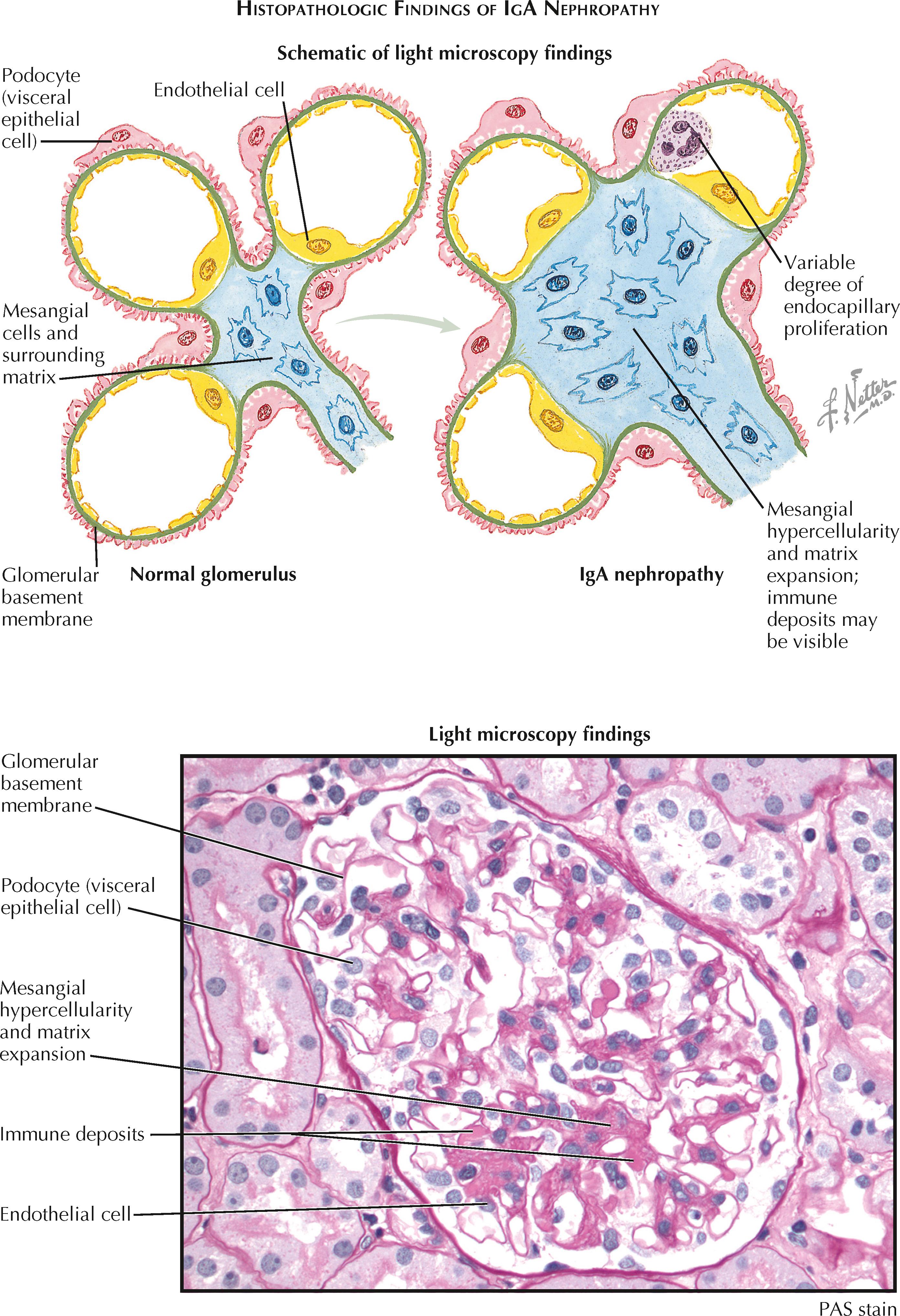
Mild to moderate mesangial hypercellularity is typically seen using light microscopy. A subset of cases feature endocapillary hypercellularity, which can be segmental or global, focal or diffuse, and with or without sclerosing lesions. Proliferation and sclerosis often coexist in the same biopsy, which suggests that proliferative lesions lead to scarring and sclerosis. Extracapillary cellular crescents (see Plate 4-25 ) may occur if there is diffuse endocapillary hypercellularity, but these rarely involve more than 50% of glomeruli. IgA immune deposits may be seen in the mesangium and, in cases with endocapillary proliferation, the subendothelium.
The degree of tubular atrophy and interstitial fibrosis generally reflects the degree of glomerular scarring. Tubules may contain intraluminal RBCs. In cases of severe hematuria, the RBCs may cause tubular obstruction with subsequent tubular injury. In cases with long-standing hematuria, tubules may show hemosiderin granules. If there is hypertension, arterial vessels typically show a proportionate degree of mild to moderate medial sclerosis and intimal fibrosis. True vasculitis, however, is rare and suggests the alternative diagnosis of Henoch-Schönlein purpura.
On immunofluorescence (IF) microscopy, granular mesangial IgA deposits are seen; dominant or codominant IgA deposition is diagnostic of IgAN. A variable degree of subendothelial deposition may also be seen, which correlates with the degree of endocapillary hypercellularity. IgG and IgM deposits are present in up to 50% of IgAN biopsies, but their staining intensity should not exceed that of IgA. C3 deposits are usually present but C1q staining is typically absent.
Electron microscopy demonstrates electron dense deposits at sites corresponding to the IF staining pattern, which is typically mesangial and, less commonly, subendothelial. Endothelial tubulo-reticular inclusions should not be present because they suggest the alternate diagnosis of lupus nephritis. Podocyte foot process effacement is usually focal and confined to capillary loops that have either sclerosis or endocapillary hypercellularity (and subendothelial deposits). The finding of diffuse (>50%) foot process effacement in a majority of capillary loops, without accompanying subendothelial deposits, is seen in cases of IgAN with coexistent minimal change disease (MCD).
The pathologic findings of dominant or co-dominant IgA glomerular staining are identical to those seen in renal biopsies of patients with Henoch-Schönlein purpura (HSP, see Plate 4-61 ). IgAN and HSP are thus distinguished based on the presence or absence of extrarenal disease. HSP is a multisystem vasculitis affecting small vessels of the skin, gut, and kidney. Purpura occurs in all cases, whereas arthritis/arthralgias, abdominal pain, and/or renal involvement occur in a subset.
No specific therapy is indicated for those with isolated hematuria. Instead, such patients should be closely monitored for the development of hypertension, proteinuria, or renal insufficiency.
In contrast, all patients with proteinuria should be started on an ACE inhibitor or ARB, regardless of blood pressure level, because of their antiproteinuric effect. High-dose fish oil supplements may also help reduce proteinuria and slow the progression of disease in patients with proteinuria >1 g/day and renal insufficiency; however, their effects have been inconsistent in clinical trials.
Patients with persistent proteinuria (typically >1 g/day) are typically candidates for immunosuppression with steroids. A typical 6-month regimen uses pulse methylprednisolone for 3 days during months 0, 3, and 6, with daily oral prednisone for all 6 months. For those patients with rapidly progressive glomerulonephritis and extensive crescent formation, the administration of steroids and cyclophosphamide may improve prognosis. The benefit of other agents, such as cyclosporine and mycophenolate mofetil, has not been proven.
The rate of progression is typically slow, with about half of patients progressing to ESRD within 20 years of diagnosis.
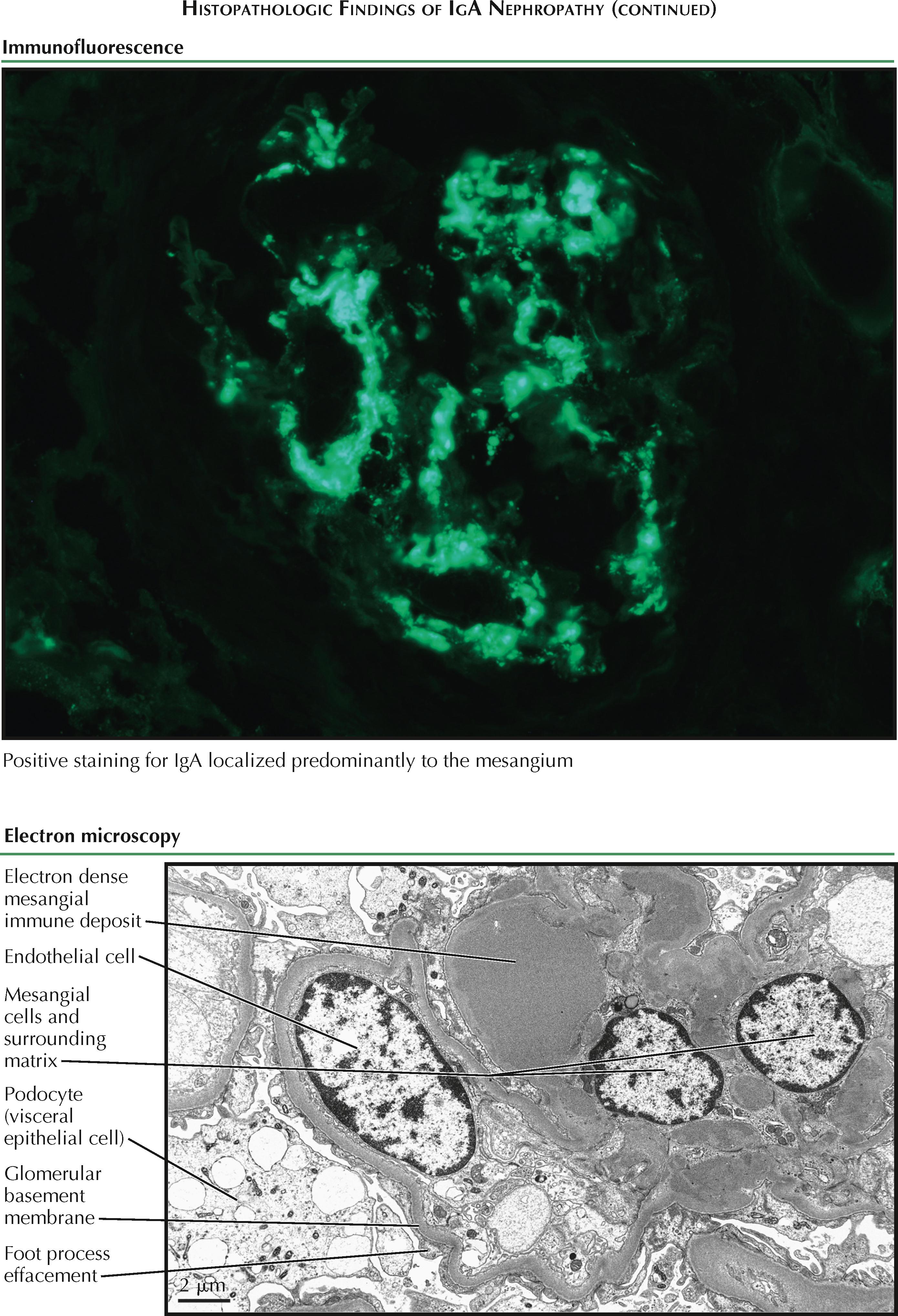
The clinical features associated with worse outcomes include persistent proteinuria (>1 g/day), elevated serum creatinine concentration at diagnosis, and poorly controlled hypertension.
The pathologic features associated with worse outcomes include moderate to severe mesangial hypercellularity, the presence of endocapillary hypercellularity, segmental sclerosis, and tubular atrophy/interstitial fibrosis affecting more than 25% of the cortical area. Similarly, the presence of extensive cellular crescent formation portends worse outcomes.
Although IgA deposition recurs in up to 50% of renal allograft recipients, this is usually an isolated immunohistochemical finding, without significant glomerular hypercellularity or clinical signs of disease (e.g., hematuria and proteinuria). Graft loss from recurrent IgAN is rare.
Compared with primary IgAN, secondary IgAN appears to have a lower rate of progression to end-stage renal disease. In most cases, the clinical course is dominated by the underlying disease (e.g., alcoholic cirrhosis).
Postinfectious glomerulonephritis (PIGN) is a syndrome of glomerular injury that occurs as a result of the immune system's response to certain infections. The archetypal example is poststreptococcal glomerulonephritis (PSGN), an acute nephritis that develops following streptococcal infections of the skin or throat, and among the oldest described nephrologic diseases. Many infections can cause PIGN, but the unifying feature is immune complex deposition in the glomerulus that triggers inflammatory injury.
A variety of bacteria, fungi, viruses, and parasites have been specifically associated with certain patterns of glomerular injury, including membranoproliferative glomerulonephritis (see Plate 4-22 ) and membranous nephropathy (see Plate 4-12 ).
Most clinically evident PIGN, however, results from bacterial infections. Classically, PIGN occurs in children after infection of the skin or oropharynx with specific nephritogenic strains of Group A Streptococcus (GAS). Although this picture remains true in the developing world, recent series from developed countries show Staphylococcus spp. now equaling or outnumbering Streptococcus spp. as the most common cause of PIGN. In addition, as many as one third to one half of cases are caused by Gram-negative organisms. Furthermore, those at risk are no longer children but rather adults over the age of 40, often with medical comorbidities such as diabetes and alcoholism. These epidemiologic shifts are most likely due to widespread availability and use of antibiotics for the treatment and prophylaxis of bacterial pharyngitis.
While the full pathogenesis of PIGN is incompletely understood, it is known to occur in only a minority of patients infected with recognized nephritogenic organisms. This observation implies that host susceptibility factors play a crucial role, in addition to specific traits of the infectious organisms themselves.
Fundamentally, nephritogenic infections present certain pathogenic antigens to the immune system, which responds by generating antibodies and forming immune complexes. These complexes may either form in the circulation and then deposit in the glomerulus during filtration, or they may form in the glomerulus in situ. Classically, immune complex deposits are found in the subepithelial space. The complexes activate complement (especially the alternative pathway) and lead to the recruitment of inflammatory cells (such as macrophages) to the glomerulus, producing immune-mediated damage.
One postulated mechanism underlying this process is molecular mimicry, in which the infectious organism presents antigens that, by coincidence, are structurally similar to normal components of the glomerular filtration barrier, such as laminin or collagen. Consequently, the immune response against the organism becomes inadvertently directed against the glomerulus as well.
Another potential mechanism for immune complex formation is that the infectious organism produces specifically nephritogenic antigens that bind to the glomerular capillary wall and activate an immune response. In the case of PSGN, two proteins produced by streptococci bear special mention: nephritis-associated streptococcal plasmin receptor (NAPlr) and streptococcal cationic proteinase exotoxin B (SpeB). NAPlr is thought to bind to glomeruli, where it captures plasmin and leads to activation of the alternative complement pathway. SpeB, with its zymogen precursor zSpeB, is an exotoxin produced by Streptococcus pyogenes that also binds plasmin and can activate leukocytes. One series of patients with PSGN reported the presence of glomerular deposits containing SpeB in 12 of 17 biopsies, and circulating antibodies to SpeB in all patients (53 of 53).
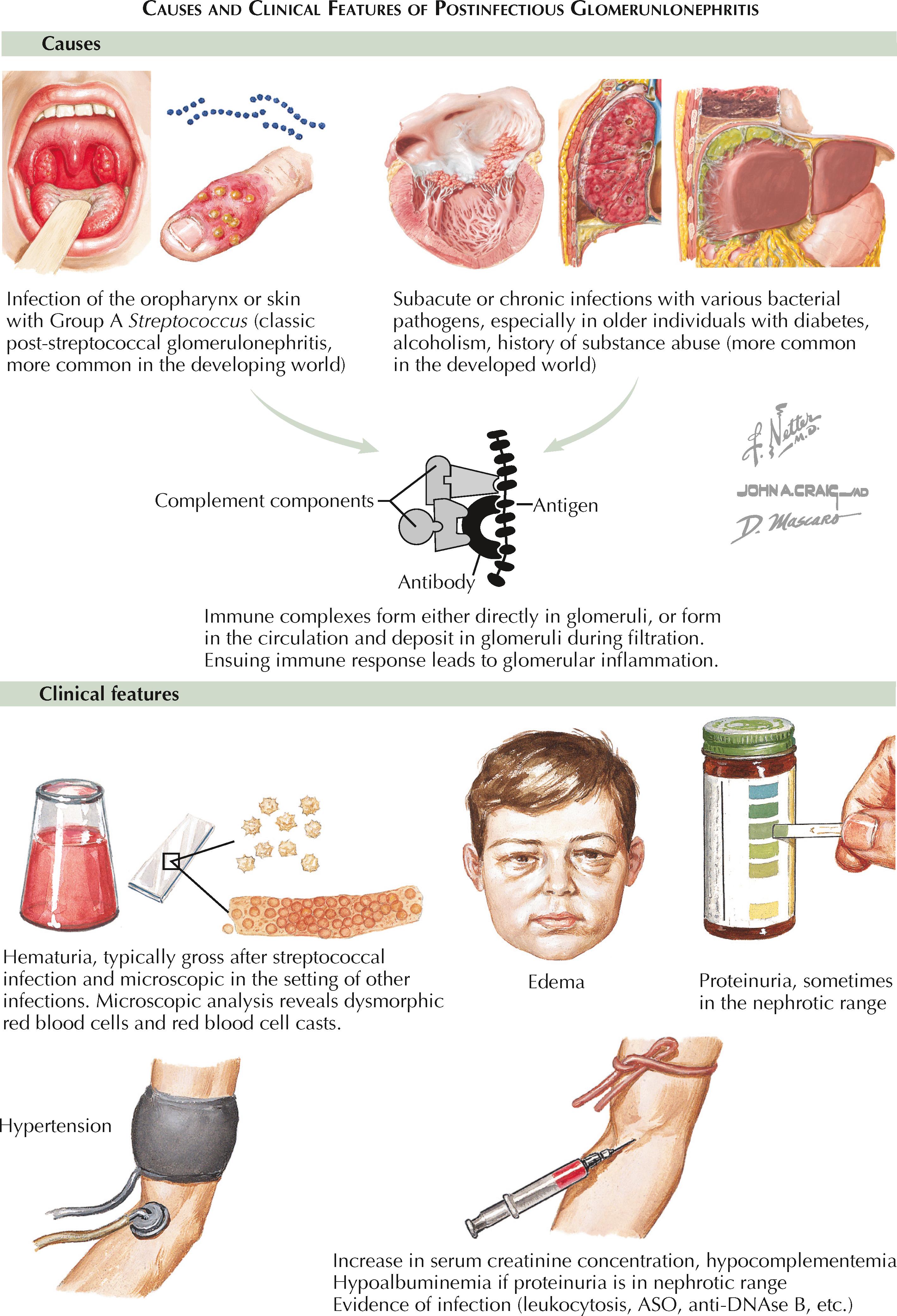
The clinical manifestations of PIGN are variable and depend on characteristics of both host and pathogen.
Poststreptococcal disease (PSGN) classically presents as a child aged 5 to 12 who develops gross hematuria 1020 days after a bout of pharyngitis or pyoderma. It typically causes an acute nephritic syndrome, with microscopic or gross hematuria, proteinuria, and hypertension. Often, facial edema and a mild decrease in renal function are seen as well. Occasionally the proteinuria is severe enough to cause nephrotic syndrome. In less than 1% of cases, rapidly progressive glomerulonephritis occurs, leading to severe renal failure that requires dialysis. When confronted with a child who has gross hematuria following an upper respiratory infection (URI), the crucial differential is between PSGN and IgA nephropathy (IgAN), which can have similar presentations. The key to diagnosis comes from the history and lies in the latency period between pharyngitis and hematuria; for PSGN, it usually takes 10 to 14 days for the hematuria to develop (or even 3 weeks following skin infection), whereas in IgAN hematuria occurs within 5 days of URI. Patients with IgAN may also report having similar hematuric episodes in the past.
As opposed to “classic” PSGN, PIGN in the developed world most commonly occurs in older individuals with subacute or chronic infections (acute and subacute bacterial endocarditis, pulmonary infections, visceral abscesses, infected ventriculoatrial shunts) who have significant medical comorbidities, especially those causing immune compromise (such as diabetes, malignancy, and substance abuse). These infections frequently require prolonged courses of treatment, and renal abnormalities often develop before the infection is entirely eradicated. Microscopic hematuria is present in up to 90%, with greater than 1 g/day proteinuria in roughly 4 of 5 patients, and the full nephrotic syndrome in about a quarter of patients. Unlike in PSGN, however, gross hematuria is rare.
Further laboratory testing can help narrow the diagnosis to PIGN. PIGN is one of the glomerulonephritides, for example, in which serum complement levels are low (the others being lupus nephritis, MPGN, and cryoglobulinemic GN). Hypocomplementemia is present in 60% to 70% of patients with PIGN, and closer to 90% of patients with PSGN. Typically C3 is significantly depressed, whereas C4 is only slightly depressed or normal, which suggests activation of the alternate complement pathway. Of note, a child with presumed PSGN and hypocomplementemia whose complement levels do not return to normal within 8 to 12 weeks should be evaluated for MPGN.
The specific diagnosis of PSGN is supported by serologic evidence of recent streptococcal infection. Several different antistreptococcal antibodies can be measured. The most common is the antistreptolysin O titer (ASO). Although this assay is highly sensitive for recent streptococcal pharyngitis, it will be negative following 50% of streptococcal skin infections. Anti-DNAse B antibody, in contrast, is less sensitive for pharyngeal infections but is 90% sensitive for recent streptococcal skin infections. The diagnosis of PSGN can often be made clinically without a kidney biopsy, especially in children with a typical course. Indications for biopsy might include repeated negative testing for antistreptococcal serologies, persistent renal insufficiency, persistent proteinuria, or hypocomplementemia beyond 8 to 12 weeks.
In adults with suspected PIGN, however, the picture is often clouded by the presence of medical comorbidities, comorbid renal disease, and medication or antibiotic use. Many other types of glomerular disease may be possible depending on the history, such as diabetic nephropathy, membranous nephropathy related to malignancy, or reactive amyloidosis. Older patients with atheroemboli may also have depressed complement levels and hematuria. Antibiotics used to treat active infections may cause acute interstitial nephritis or toxic tubular injury. For these reasons, a kidney biopsy becomes invaluable for elucidating the diagnosis.
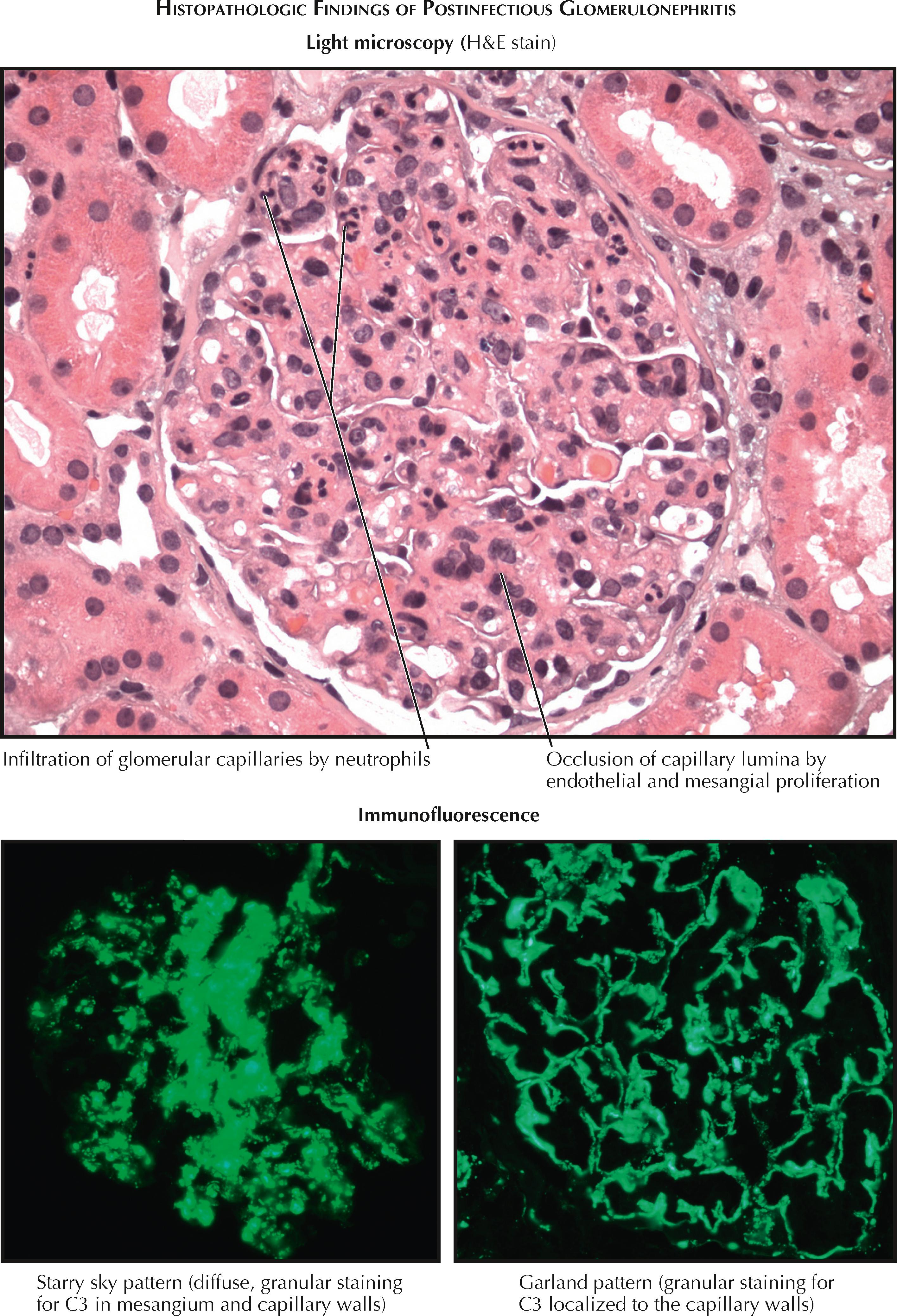
Several different histologic findings may be present in PIGN, and the diagnosis can usually be made using light microscopy and immunofluorescence. On light microscopy, PIGN classically causes diffuse hypercellularity involving all of the glomeruli, with the capillary lumina obscured by endothelial proliferation, mesangial proliferation, and infiltration by monocytes and neutrophils. Silver stain may reveal characteristic postinfectious humps in the subepithelial space. These humps represent deposits of immune complexes that include complement and immunoglobulins. Immunofluorescence usually shows granular deposition of C3 and IgG, and occasionally IgM. This staining may follow the capillary wall (“garland”) or it may be more diffuse (“starry sky.”) Electron microscopy will show large dome-shaped humps in the subepithelium, and it may also show small immune complexes in the mesangium and subendothelium.
In the rare cases when acute PIGN leads to rapidly progressive glomerulonephritis, histology will show disruption of the glomerular basement membrane and the formation of cellular crescents. This presentation appears to occur more frequently with Staphylococcus aureus infections.
It must be noted that many people experience asymptomatic or subclinical urinary abnormalities (low-level proteinuria, pyuria, and microscopic hematuria) following trivial or self-limited bacterial or viral infections. Although the exact frequency is difficult to determine, at least one series of patients with GAS pharyngitis revealed 24% to have subclinical glomerulonephritis by urinalysis, and almost all had corresponding abnormalities (i.e., mild mesangial proliferation or hypercellularity) on kidney biopsy. An older, larger series in children found that subclinical disease was 20 times more likely than overt glomerulonephritis. These observations support the notion that a large proportion of mild and transient PIGN goes unrecognized.
There is no specific treatment for PIGN other than removing the trigger for autoimmune attack. Here the term “postinfectious” can be dangerously misleading because, as previously stated, the renal disease often begins during the course of a chronic infection. To limit the inflammatory process, the infection must be identified and eradicated. A biopsy that shows PIGN with no previously suspected source should prompt a thorough investigation for occult sources of infection, including blood cultures to evaluate for subacute bacterial endocarditis, a careful dental examination, and evaluation of any indwelling foreign bodies such as ventriculoatrial shunts, vascular grafts, or pacemaker wires. Meanwhile, any person diagnosed with PSGN should be treated with a full course of antibiotics to eliminate any residual infection.
Unfortunately, PIGN may progress despite eradication of infection, especially in the setting of infection with S. aureus or Brucella . In such cases, immunosuppressive treatment is sometimes attempted. Similarly, in crescentic PIGN there has been anecdotal use of corticosteroids and or cytotoxic agents with some success. No high-quality clinical trials, however, have been performed.
A separate issue is the question of routine antibiotic treatment of pharyngitis to prevent the development of PSGN. Because the majority of pharyngitis cases are not caused by GAS, and because even GAS pharyngitis usually has a benign course, empiric antibiotics are discouraged. Several useful clinical decision algorithms to predict the likelihood of bacterial pharyngitis and guide antibiotic therapy have been proposed, such as the Centor criteria. Indeterminate scores should not be treated with antibiotics unless there is a positive rapid streptococcal antigen test or a positive throat culture. The exception is for epidemics of GAS, where close contacts to infected cases should receive prophylactic treatment with penicillin.
The prognosis for PIGN varies according to age and comorbidities. The prognosis for children with PSGN is excellent; nephritic symptoms usually begin to improve within a week of presentation, and full recovery is the norm. Approximately 20% of children may have persistent urinary abnormalities over the long term (5 to 18 years), but impaired glomerular filtration is uncommon.
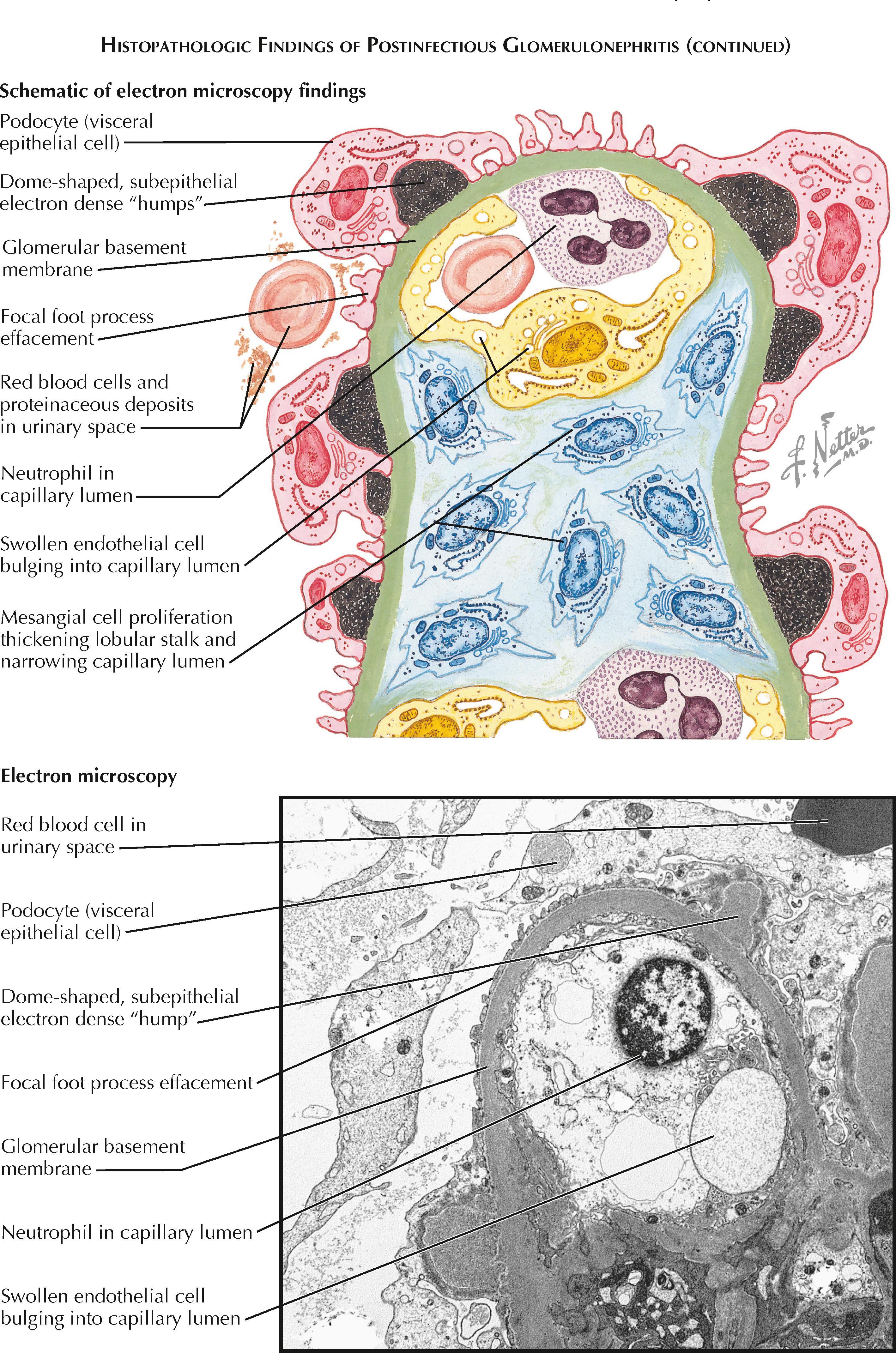
In adults, the prognosis is much worse, likely in large part due to the underlying comorbidities and chronic infections that predispose to PIGN. Only about half of patients will achieve complete remission of their renal disease. Poor prognostic indicators include age over 60 years, nephrotic-range proteinuria, “garland” immunofluorescence pattern, and crescentic glomerulonephritis. Especially poor outcomes occur in patients with underlying diabetic glomerulosclerosis, with one study reporting all affected patients having permanently impaired renal function and more than 80% reaching ESRD during a mean follow-up of 19 months.
Membranoproliferative glomerulonephritis (MPGN) is a pattern of glomerular disease that can occur either as an idiopathic, primary phenomenon or secondary to numerous systemic conditions. It is a rare disorder, and its incidence appears to be decreasing, particularly in the developed world.
MPGN is sometimes known as “mesangiocapillary glomerulonephritis” because the major histologic features include mesangial expansion, thickening of glomerular capillaries, and interposition of mesangial matrix into the glomerular basement membrane. Alternatively, because of the lobular appearance of the glomerulus following mesangial expansion, MPGN is sometimes termed “lobular glomerulonephritis.” These morphologic changes are responsible for the major symptoms of this disorder, which include hematuria and a variable degree of proteinuria.
There are three subtypes of MPGN, which are distinguished based on their electron microscopy features:
MPGN—immune complex deposits seen mainly in the glomerular capillary subendothelium and mesangium.
MPGN (Dense Deposit Disease)—diffuse, electron-dense, intramembranous deposits seen within the glomerular, tubular, and arteriolar basement membranes
MPGN—a morphologic variant of type I MPGN with prominent subepithelial deposits.
Activation of the complement system appears to be the central, unifying pathophysiologic mechanism in all MPGN subtypes. Indeed, “hypocomplementemic glomerulonephritis” is yet another term often used to imply MPGN. The specific cause of complement activation, however, appears to differ among the subtypes.
In type I MPGN, the most common form, immune complexes deposit in the mesangium and glomerular subendothelium, then activate the classical complement pathway. These immune complexes can be either idiopathic or secondary to other disease processes, including chronic infections (chronic hepatitis C with or without detectable cryoglobulinemia, chronic hepatitis B, subacute bacterial endocarditis, infected ventriculoatrial shunt, malaria, schistosomiasis), autoimmune disease (systemic lupus erythematosus, Sjögren syndrome), and hematologic disorders (essential cryoglobulinemia, Waldenström macroglobulinemia, chronic lymphocytic leukemia).
The exact proportion of idiopathic versus secondary type I MPGN is difficult to estimate; however, in recent years, it has been appreciated that HCV and cryoglobulinemia are responsible for many of the cases that had previously been considered idiopathic. Cryoglobulins are proteins that precipitate when blood is cooled below 37° C. They mostly consist of immunoglobulin and complement components, and they are found in conditions of chronic immune stimulation or lymphoproliferation, such as hepatitis C infection, HIV infection, and lymphoproliferative disorders.
In DDD, complement activation is antibody-independent and instead occurs in the setting of dysregulated activation. Moreover, complement activation follows the alternative rather than classic pathway. Complement activation occurs by two major mechanisms. At least 80% of patients produce an autoantibody known as C3 nephritic factor (C3NeF), which stabilizes C3 convertase. In a smaller fraction of patients, there is functional loss of factor H, the major inhibitor of C3 convertase, because of either genetic mutations or antifactor H antibodies. Both C3Nef and loss of factor H cause chronic overactivation of C3 convertase, with subsequent complement activation and C3 consumption.
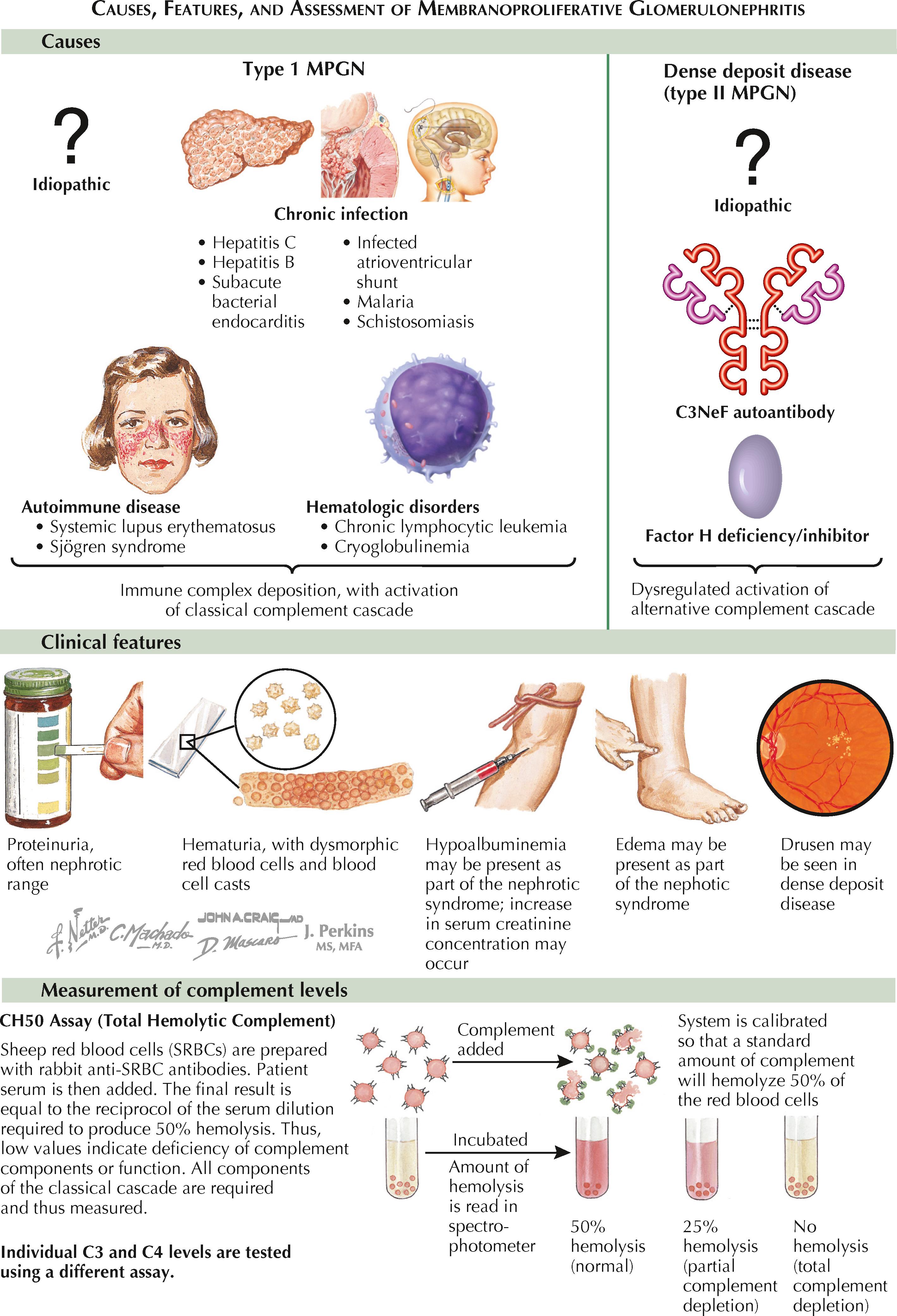
The pathogenesis of type III MPGN appears similar to that of type I MPGN. Indeed, many consider type III MPGN to be a morphologic variant of type I, although the pathogenetic mechanisms underlying the differences seen on electron microscopy remain poorly understood.
In all MPGN types, complement activation drives injury to the glomerular capillaries and mesangium. Inflammatory cells, especially monocytes, may be recruited to various degrees and contribute to the damage. Following inflammation, reactive processes of cellular proliferation and repair cause mesangial matrix expansion, as well as duplication of the glomerular basement membrane. By disrupting the normal components of the filtration barrier, these inflammatory processes result in hematuria and proteinuria.
The different MPGN subtypes generally present in childhood and young adulthood, and all are essentially indistinguishable with respect to their renal manifestations. The most common presentation of MPGN is the nephrotic syndrome, which is present in approximately half of patients. Even in those without overt nephrotic syndrome, a varying degree of proteinuria is almost always present. Microscopic hematuria is found in nearly 90% of cases, usually featuring dysmorphic erythrocytes but occasionally red blood cell casts as well. Up to 20% of patients may have acute glomerulonephritis.
One extrarenal manifestation particular to DDD is the development of ocular deposits known as drusen. These whitish-yellow deposits lie beneath the retinal pigment epithelium and can be seen during funduscopic examination. These lesions are also characteristic of age-related macular degeneration. The reason for drusen formation in DDD is not entirely clear; however, drusen have been found to have similar oligosaccharide composition to the electron-dense glomerular deposits, implying a possible common pathogenesis. In addition, DDD is sometimes associated with acquired partial lipodystrophy (APL), a syndrome characterized by the loss of subcutaneous fat in the upper half of the body and C3 hypocomplementemia. This phenomenon, frequently associated with C3NeF, may reflect complement-dependent lysis of adipocytes expressing high amounts of complement components, such as factor D (also known as adipsin).
In any patient for whom MPGN is on the differential, complement levels should be assessed—specifically, C3, C4, and CH50 (total hemolytic complement, a functional assay of the complete cascade). The finding of hypocomplementemia is generally useful in the assessment of glomerulonephritis because it is present in only a few types: MPGN, cryoglobulinemic vasculitis, lupus nephritis, and postinfectious glomerulonephritis. In types I and III MPGN, where the classic pathway is activated, the typical pattern is a low or normal C3, low C4, and low CH50. In DDD, characteristically C3 is markedly decreased and CH50 is also low, whereas C4 is normal, which reflects activation of the alternative pathway. While these patterns are helpful, it must be noted that they are neither sensitive nor specific for the diagnosis of MPGN or its subtypes.
The definitive diagnosis of MPGN can only be established based on histopathologic findings. The general pattern of MPGN is usually readily recognized on light microscopy, although this modality cannot differentiate between the subtypes. Two basic features are characteristic: (1) mesangial proliferation with hypercellularity and/or matrix expansion, often leading to pronounced lobulation of the glomerulus, and (2) thickening of the capillary basement membrane. Capillary loop thickening and interposition of matrix or inflammatory cells often results in a splitting or duplication of the basement membrane, which assumes the classic double-contoured “tram track” appearance. An exudative form of MPGN can also be seen, especially in cryoglobulinemic glomerulonephritis, which is characterized by massive glomerular infiltration by inflammatory cells, particularly monocytes.
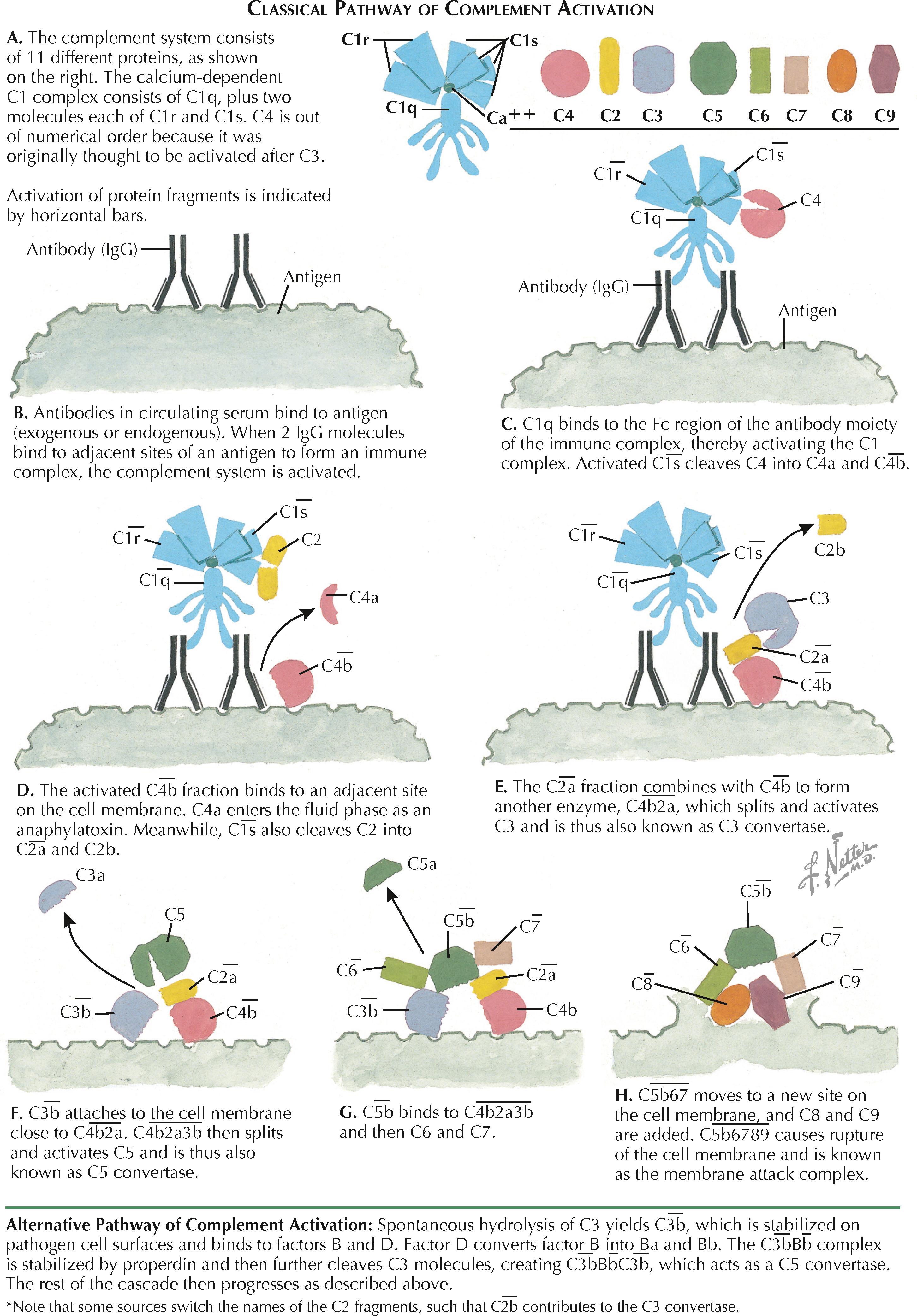
On immunofluorescence, types I and III MPGN usually show prominent granular capillary wall staining with C3, variable amounts of IgG and IgM, and sometimes C1q and C4. In contrast, in DDD the capillary wall typically stains with C3 in isolation.
The definitive distinction between MPGN sub-types can only be made with electron microscopy. In type I MPGN, immune deposits are seen in the subendothelium, whereas in type III they are also seen in the subepithelium. In DDD, pathognomonic electron-dense, intramembranous deposits are seen in the glomerular basement membrane. In many cases, these deposits are also present in the basement membranes of the tubules and arterioles. While the exact composition of the deposits has not been determined, they appear to contain glycoproteins similar to normal glomerular basement membrane, and they do not appear to contain antigenic material, immunoglobulins, or complement. In all subtypes, podocyte foot processes appear diffusely effaced.
If type I MPGN is diagnosed, the clinician must undertake a careful evaluation to rule out potentially causative systemic disease. This is particularly important because some of those diseases, such as parasitic infections, may be otherwise subclinical but amenable to treatment. All patients should be tested for hepatitis C and B, as well as for cryoglobulins. A negative HCV-antibody test in the presence of cryoglobulins should be interpreted with caution because the antibodies to virus may complex with the cryoglobulins and become undetectable by standard assays. If HCV is ruled out, tests for other chronic infections, autoimmune disease, or dysproteinemias should follow as appropriate. Any patient with a ventriculoatrial shunt should be considered infected until proven otherwise. Idiopathic type I MPGN should remain a diagnosis of exclusion.
If DDD is diagnosed, an assay for C3NeF should be sent and a screen for factor H mutations and activity should be performed. While none of these tests are diagnostic, they are crucial for planning therapy.
Become a Clinical Tree membership for Full access and enjoy Unlimited articles
If you are a member. Log in here